Employee onboarding process

Ivan Andreev
Demand Generation & Capture Strategist, Valamis
January 17, 2022 · updated April 3, 2024
23 minute read
After reading this guide you will know what a good onboarding process can bring to your organization and how you can improve your organization’s current process.
Learning more about onboarding process will help you create a better learning path for employees, find potential skill gaps, improve employee development , and will ultimately allow you to create better teams.

What is the employee onboarding?
Benefits of properly set employee onboarding process.
- Pre-onboarding: first impression and recruitment
- Onboarding on the first day
- Onboarding on the first week
- Onboarding during 1 month
Employee onboarding process best practices
Remote onboarding tips, faq about onboarding process.
Employee onboarding is the process by which new employees are introduced to the social and performance aspects of their new job, with the goal of getting new hires adjusted quickly, increasing productivity and job satisfaction, and reducing turnover.
This process includes teaching new hires about the attitudes, competencies, company culture, employee expectations and the behaviours required to function effectively within an organisation.
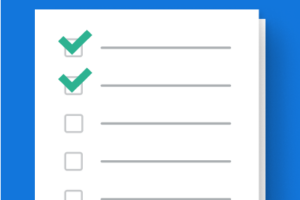
Onboarding checklist
Ensure a smooth and effective onboarding process for your new hires and set them up for success.
1. Acclimatise the employee in the briefest period possible
When the employee is brought in, they need to be taught not only where to park and where the best lunch spots are, but they also need to know exactly what is expected from them, where to find support within their peers and management team, and exactly what they can expect from the company.
Setting clear expectations allows your employee to understand their role from day one.
2. Decrease the time it takes for your new employee to become productive
The better the onboarding process, the quicker your new employee will be able to settle down to work and begin being productive.
If you have an inefficient or confusing program, your employee will waste their first few weeks having to ask questions that they should already know the answers to.
Set them up for success with clear onboarding materials that answer all the questions they may ask about their role or the company.
3. Properly engage the employee
Engaged employees increase productivity, profitability, and product quality, among other positive outcomes.
Engagement in this context means that the management team is showing that they value the employee, recognize their talents, and are committed to fostering their professional growth.
53% of HR professionals say that better onboarding creates engaged employees , which then carries over to their career within the company.
An organisation’s onboarding is the first look an employee has at the structure, politics, and support within the company.
You should strive to make sure that it is a positive experience.
4. Good onboarding programs directly improve employee retention
About ⅓ of employee turnover happens during the first 90 days.
This is attributed to poor onboarding and organizations who leave their employees to ‘fend for themselves’ and ‘sink or swim’ mindsets.
Costs associated with replacing an employee can be as much as 150% of their annual salary. This includes hidden costs such as decreased productivity, the loss of special knowledge and a reduction in morale among remaining staff.
Employee retention can save the company thousands of dollars.
5. A good onboarding process will promote a better company culture
By setting the tone from the first day, you build a strong culture within your company of employees being valued, taught, and supported.
New employees immediately understand and feel welcomed by the company, and existing employees see that the workforce is valued.
Specific company values are communicated clearly.
1. Pre-onboarding: first impression and recruitment
The onboarding process starts when a potential candidate reads a job application or when they get the first impression of your company somewhere else.
Your employer branding actions (including job applications) are aimed at supporting your onboarding process.
You should create content that sends signals about a caring, fun, development orientated organization. You should translate your values, culture, and team spirit.
When creating job applications, remember that not only are you trying to attract the best candidates, you are also selling your company as a good place to work. Be clear about the expectations of the role, and the skills of your ideal candidate, but remember to offer enticing insights into why your organization is a good place to work.
During the recruitment process, your organization’s HR team will post about the open role on the relevant websites, collect and review applications, interview the top candidates, and should ultimately end with the most qualified candidate being offered the job. At this point, there may be a period of negotiation with the top candidate before the job offer is accepted.
This is, of course, a simplification of the process. Recruitment is a massive job and should be taken very seriously. Companies without good recruitment practices will often find that they are not attracting or hiring the best people.
Goals for pre-onboarding stage
- Attract relevant candidates. You want to reach people who share the same values, who will be a good fit, and who will bring relevant skills to your organization.
- Clearly communicate what your organization is looking for in each role you are recruiting. Who is the ideal candidate? What skills, knowledge or passions should they have?
- Create a positive impression and leave people with a clear understanding of who you are as a company. It’s the first touchpoint, not all of the people you reach will apply but they should be left with a positive impression about your company.
Best practices
1. Create a company culture page on your website. Use the page to show your working culture, the people of your organization, and their values.

2. Review all your assets that might be first touchpoints for a potential candidate. It can be your website, social media, the company page on a job website, and so on. Update them, and make sure they fit your company brand. Look at clarity, consistency and tone.
3. Review job listings and interview questions using the same criteria as above.
- Are your listings inclusive?
- Do they represent your company well, and will they attract the people you want?
- Is there room for improvement?
4. Have a policy of transparency in regards to policies that impact your employees. Policies around maternal or paternal leave, working remotely, vacation time, bonuses, or expected weekly hours should be clearly communicated and easily accessible.
5. Begin the process of onboarding with an office tour, welcome letter, informational packet and company-wide announcement of the new hire.
6. Send an official offer letter. This should clearly outline the top-level responsibilities of the role, as well as all requirements and expectations. This is where you can make sure that everything about the role is communicated clearly, and there will be no unpleasant surprises. This doesn’t have to be an extra formal letter, though! Let the personality of your organization shine through, include information about the team, their pets and hobbies, or other fun facts about the company.
7. After the job has been offered, set up an office tour, if possible, and begin the onboarding process by giving access to the company training portal, company email account, and all other details.
8. Liaise will all relevant stakeholders about the new hire, their role in the onboarding plan and allocate resources for training. Everyone should know their responsibilities, which include developing the itinerary for the new employee’s first week, setting goals, assigning an onboarding buddy and clearly laying out the path to success for this person.
2. Onboarding on the first day
An HR person should welcome the new employee, showing them to their workstation, and delivering all necessities. This will include office keys, equipment, codes, badges, passwords, introductions to key software programs, providing introductions and an office tour.
If you have a learning environment, introduce it. It is great to have a mandatory learning path for all new employees. This is how you can effectively cover the most important things about the company, including what you do, the products you make, key people, organizational history and anything you think will be valuable.
It’s especially important to include guides and tips on how to use company software, intranet, communication channels and so on.
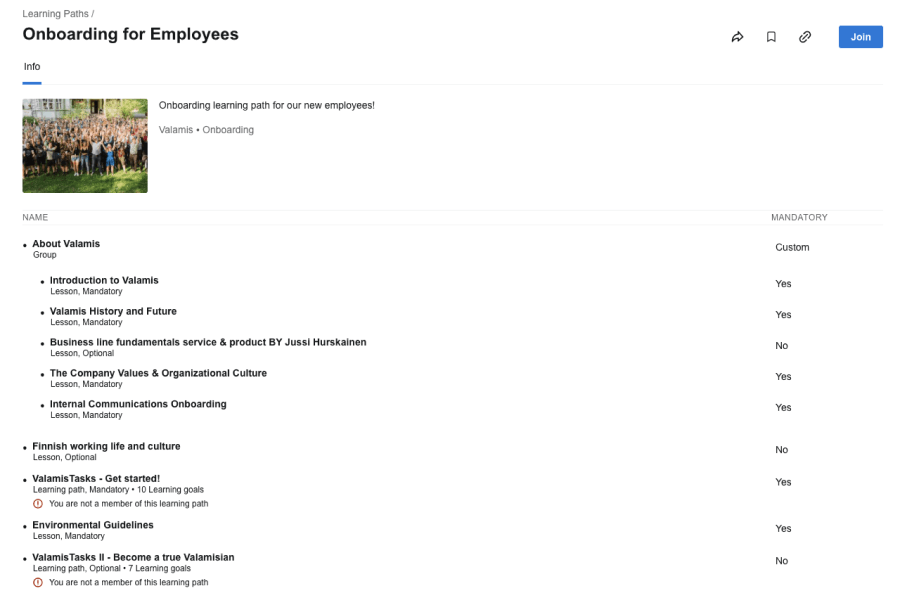
Employee onboarding learning path inside Valamis learning environment.
On the first day, a meeting with the new hire’s direct manager should be arranged. This is where the onboarding plan should be shared with the new hire, alongside an explanation of the training and short and long-term goals. The new hire should be encouraged to ask questions, and stakeholders should endeavour to help the new hire get settled in quickly.
Goals for the first day
- Make your new employee comfortable and welcomed from the first moment. The first day should be focused on introductions, positive impressions, new colleagues and the first look at what the person will be working on in their new role.
- Establish the expectations for the new role with the employee. As the new employee is introduced to their team, clarify each person’s role and how they will be interacting as a team going forward.
1. Print a Welcome poster with the name and title of the new hire. Attach it to the office main door (outside of course). This is a really simple way to pay attention to the new employee(s) and also an easy way to show other colleagues that they should welcome their new co-worker on their first day.

Valamis welcome poster
2. Create a welcome package. When a new employee starts, put a small package at their table. This gift might include some brand-related material, for example, a mug, beanie, shirt, beer, candies or similar. It’s a great idea to make a personalized mug, with the new employee’s name on it, their starting date and a personalized slogan. Choosing the slogan might be one of the tasks to do in the onboarding process.

Example of welcome package
3. Organize a welcome coffee, and invite all office employees to participate. You can even order a cake or some sweets. This creates a great experience and opens up the team to get to know each other, allowing them to tell something about themselves and learn more about each other. Come up with a list of simple get-to-know-you questions and prompts to help move things along smoothly. If you have a lot of new employees coming in the near future, you can combine their welcome coffees and do them once a week or over several weeks, or you can limit participants to within the new hire’s department.

Welcome coffee at Valamis
4. Set up the new hire’s workstation and organise it. Make sure that their dedicated space is ready for them first thing. This includes a computer with everything installed and a list of all usernames and passwords, printed items, such as employee guides and codes of conduct, and a list of employees. Provide them with the information that they need so they know who to ask if they need something else for their job, for example, Barbara in IT can fix their connection, while Adam in HR can help with login issues.

The new hire’s workstation.
5. Assign an onboarding buddy. This is a person who is assigned to help on the first days. This is their go-to person to turn to when they inevitably have questions throughout their first few weeks. This is ideally someone on their team who has a solid idea of what their role is, can answer questions easily, and can help smooth their transition.
6. Set aside 30 minutes at the beginning of the day and 30 minutes in the end for one-on-one meetings with the new hire. This will give them space to ask questions, make observations and ensure that they are on the right track.
7. If possible, take the new employee out for lunch, create a coffee and cake meet-and-greet or other social function specifically to welcome the new employee. They should feel as though their new job is as excited to have them as they are to start.
8. Ask a new employee to observe the organization and ask them to tell if they find something to improve. A new person always has a fresh view.
3. Onboarding on the first week
It’s really important to involve new employees in work in the first week.
They will, naturally, be feeling a bit lost in this new environment, so using the onboarding buddy system is highly recommended. Find a high performer with a similar role who can show the new hire the ropes, answer questions, and generally function as their go-to support person.
Before the new hire starts, you should have already set first week goals, short-term, achievable actions that can help them feel as though they are already contributing right off the bat.
As they begin to settle in, arrange for them to have meetings with the people they will be working closely with and other important people within the organization. It is recommended to set meetings with the head of their department, and the heads of other departments that they will be working closely with. Schedule one-on-one meetings with key members of their department, if it is a large one, or with all members if it is possible.
Try to organize a meeting with the CEO. Many companies choose to schedule this during lunch, as it is more low-key and sociable, and makes the new employee feel valued.
Ideally, each person can teach them a different aspect of their new role, as well as answering general questions about the company, the technology, the products, or whatever else might come up.
This is also where the new employee will learn the general schedule they will be following: Which meetings happen on which days, who they need to check in with daily, and how long specific tasks might take them.
They will develop and understand their long and short-term goals, their immediate tasks, and what their responsibilities will be.
Goals for the first week
- Throughout the week, introduce the new hire to all of the people they will be working closely with.
- Develop an understanding of the goals for the new employee. This should include goals to achieve before the trial period ends, as well as the goals they are expected to achieve after one year and goals for longer career development. Please note: write these goals down!
- The new hire should undergo training sessions to know and be comfortable with the technology they will be using, understand their team schedule, and begin working on smaller tasks.
- The new hire has a support network that they can turn to for help.
1. Set the support team and start tasks in advance. All of this should be settled before the new hire starts. Being organized will demonstrate to the new hire that your company is stable, thoughtful, and takes the time to do things right. It gives a positive first impression.
2. Anticipate that your new hire will take some time to settle in. Be realistic about what you expect them to do, and communicate that early and often. Discuss the goals and how you will help the new hire reach them.
3. If possible, introduce the new hire to someone who has worked in their role. If that person was promoted out of the role, they will be able to share valuable insights about the growth potential of the company, best practices for fulfilling the role, and in general, will be a key person for the new hire to meet.
4. Set one-on-one sessions with team members, if possible, so they can tell the new hire more about what they are doing and introduce themselves. They can explain how the new employee can help them in their work, and be part of really important work at the very beginning of their journey.
4. Onboarding during 1 month
As your new hire settles in, you should work to provide them with ample opportunities to socialize, learn, develop themselves and integrate into the company. This can be something large, such as company-wide events like ping pong tournaments or BBQs, or smaller get-togethers, like coffee with colleagues or one-on-ones with supervisors.
Check-in with them regularly, follow up with their team and direct supervisor and make sure that they are being offered all of the resources they need. This is especially important at the one month mark. A good tool to use at a 30-day check-in is a survey. Consider the following questions, and think if there are others that you could ask a new hire that are more specific to your organization.
Example survey questions:
- Do you feel like you are a valued part of the company?
- Do you feel like the company is meeting your expectations?
- Are you experiencing any difficulties with our technologies or work-related tools?
- Do you feel like you have the tools and resources you need?
- Have you outlined your goals with your supervisor?
- Do you feel you are making progress towards your outlined goals?
- Do you know the strategic goal of the company for the future?
- Do you have any thoughts on how to make our onboarding process better?
Goals for the 1st month
- Make sure that your employee is on the path to success within your company by offering continued support, development opportunities and check-ins with relevant team members.
- Foster a community culture within your organization through team-building and one-on-one exercises.
- See how the organization’s onboarding can be improved.
1. Supervisors should establish a regular schedule for checking in with the new hire. Goals, current and upcoming projects, and concerns should be addressed in these sessions.
2. Use technology like Slack’s Donut integration to assist with connecting random team members for virtual meet and greets.
3. Have one-on-one sessions with the supervisor or department head at the end of each week. This serves to touch base, make sure that things are going smoothly, and all questions or concerns can be quickly addressed.
4. if you have a trial period in your company, set a one-on-one meeting with a supervisor after it has passed. There should also be a survey so that the HR department can learn more about overall results and employee satisfaction.
5. Create a variety of activities, so that all employees can find something for them: yoga, exercise, painting, cooking, or sports. Have a variety of different challenges and invite new employees to participate.

Cooking event: It’s better to become friends with the Head of Design during the first month.
6. Don’t stop onboarding after one month. Continue to monitor your new hire’s journey with your company, develop their talents and invest in them. Consider doing 3 month, 6 month, and 1-year check-ins.
1. Have a comprehensive, written, formal onboarding checklist
Studies have shown that companies with formal onboarding checklist report significantly better rates of retention.
You can download our onboarding checklist in PDF, PNG, Google Sheets, and Excel templates. Use them as they are, or modify them according to your needs.
Use a prepared Trello template to manage the onboarding process in your company. It will help you track each new employee, assign tasks and responsible persons, set due dates, and many other things.
New Employee Onboarding Trello template by Valamis
2. Have a detailed, written explanation of the job description
This should be developed during the hiring process and shared with all applicants, to remove the possibility of hiring a person who cannot perform the main functions of the role.
3. Select a peer to help the new employee get acclimatized in their first few weeks
In selecting this person, make sure they have a positive and helpful attitude. This will set the tone for your new employee and help them feel welcomed into this new space.
4. Involve different departments of the company
When drafting the onboarding plan, include making introductions to all of the different departments. From product development, marketing, human resources and sales, it is important to include departments other than the new hire’s department.
It makes it easier for the new employee to find points of contact inside the company and helps them to understand company structure.
5. Ensure a clean workspace and facilitate incoming paperwork
Coming into a new office and having an unclean workspace will make a person feel unwelcome or as if the company is unprepared for them.
The same goes for paperwork – having everything set up and ready will show that this person has been anticipated and is a valued member of the team already.
6. Organize an enthusiastic welcome for the new employee
Through email or a staff meeting, let everyone know that there is a new employee.
Organize a welcome lunch or another event to introduce the new hire.
The first day will set the tone for their employment, make sure your new hire feels welcomed.
7. Monitor their progress over time
Having regular check-ins at set intervals will allow management to track the onboarding process – which can take up to a year.
Making sure the employee is on track, and solving any issues that have come up, will increase the rate of employee retention.
8. Make short, medium and long-term goals clear
Without clear goals, you are leaving your employee to guess what they should be doing, and it will not end well.
By setting clear, achievable goals, you make your expectations known, you set a path towards achievement and your new hire knows where they stand.
Sit down with your employee and set one week, one month, six month and one-year goals for them, and talk through how these goals might be achieved.
Remember to write it all down!
9. Get feedback from the new employee
We cannot emphasize how important this step is!
Your new employee has got fresh eyes and recent experiences from other companies.
You want to hear their feedback about your business, processes, everything that they have encountered during their onboarding experience.
This is some of the most valuable insight you can receive, so don’t miss out on it.
10. End of probation period discussion
This should be held by the supervisor before the probation time ends.
Don’t forget, there should also be a ‘feelings check’ with HR 45 days into the new hire’s employment.
Both of these discussions open the door for the new hire to ask questions, solve issues, and generally receive company support.
11. Create a friend book
Ask employees to introduce themselves, create a friend book where employees can tell something about themselves, what they do, what they like, what are their hobbies and so on.
This helps employees to know each other better, and find friends for the new employees with similar interests inside the company.
Download book of employees template DOCX .
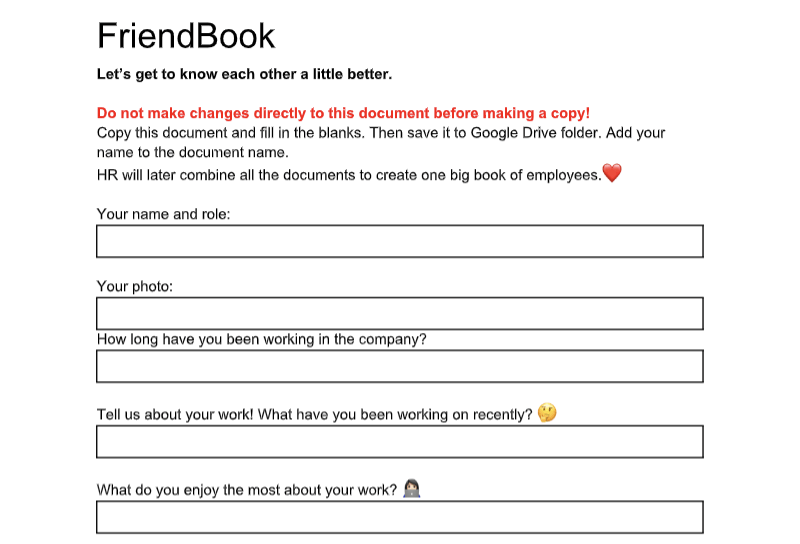
More and more, organizations are moving towards remote work. As COVID-19 has shown us, we can perform just as well, or in some cases better, when we are not in an office environment.
But one area that suffers is onboarding. Meeting new colleagues, receiving direct training, reaching out with questions – all of these are made much more difficult when everything is online.
However, there is always a solution, it just takes some creativity.
Here are some solutions that your organization can use for onboarding remote employees.
- Make sure that all of the necessary equipment has been delivered to your new hire and that they have been able to set it up. Schedule a session with an IT person a few days before they are due to log in the first time so that any issues can be found and solved before their official first day.
- Keep in mind that endless video meetings will drain a new employee. Break their schedule up with hour-long meetings followed by an hour of tasks. First-day tasks could be getting familiar with new platforms, setting up Slack, Google Drive and email, or logging into the company LMS and taking the first course. Repeat throughout the day. Set longer or more complex tasks as the onboarding continues.
- Introduce the new employee to team members in 1:1 calls, where the team member is tasked with teaching them part of their new role. Each person can offer a unique insight into the company processes and will break up the day a bit.
- Consider recording training sessions, so that the new employee can refer back to it later on. This helps them feel like they don’t have to be laser-focused 100% of the time, and they know that they won’t miss anything important.
- Don’t forget to celebrate accomplishments! Make announcements in the company-wide chat, send little gifts to team members who have gone above and beyond, reach out personally to thank people for their effort. It’s really important to foster a sense of connection in a time when so many people feel disconnected.
How long is the onboarding process?
According to this survey , onboarding programs tend to be from one day to one month long. In fact, more than 50% of onboarding programs last one week or less.
This is not ideal – in a perfect world onboarding would take at least 90 to 100 days, and could even go up to a year.
What do new hires want from onboarding?
New hires want to come in and be able to contribute quickly. They want to learn their role, their closest colleagues and know who they can turn to for help.
They also want to have a clearly defined role, a schedule created for them that they can follow the first week or two, and clear communication.
Is onboarding part of recruitment?
It is! Onboarding starts the minute that someone becomes aware of your organization, especially in relation to a job posting. The impression that you give will stick with the person, so you should strive to make sure it is a good one.
During the recruitment stage, it is especially important to cover some of the first steps of onboarding, so potential employees know what to expect from your organization. If you have a good onboarding program, you will find that it is easier to recruit quality employees.
Is onboarding the same as training?
Onboarding and training often go hand in hand, but they are different things.
Training is about teaching new skills to a person and has to do with the tasks the new hire is expected to perform.
Onboarding is about bringing a new person into the culture of the company, integrating them in with the staff, the management and the overall environment.
Does orientation count as the start date?
It can, depending on when it happens, before the starting day or on the first day.
Some organizations choose to have an orientation session before the official start date, others have the two on the same day.
What is the difference between a new hire orientation and onboarding?
A new hire orientation is a one-time event, usually on the first day, where new employees are formally introduced to the company values, ethos, leaders, policies and administrative procedures.
Onboarding is a much longer process, which does include orientation, and is where the new hire is introduced to all aspects of their new role. This usually includes job training, goal-setting, introduction to company culture, meeting other employees and serves to help the new hire get adjusted quickly and become productive.
You might be interested in
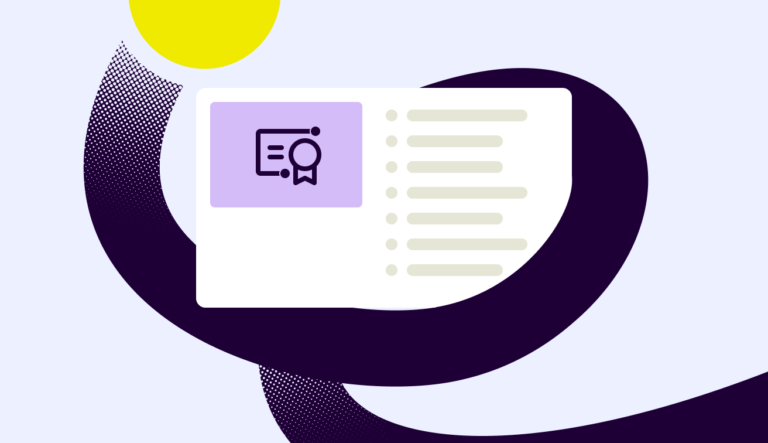
What is an Learning Management System (LMS)
Find out what a Learning Management System is. What does it do? What are the benefits of having LMS, and how to select the best LMS for your organization?

How to create an effective Learning and Development (L&D) strategy

How to minimize time to value in L&D initiatives
Get access to 100's of HR resources in HRM INSIDER
- SIGN UP FREE
A Guide to Onboarding: Set up a Great Employee Experience

You did it! After several weeks (maybe even months), and hours of interviewing and assessing talent, you found the best candidate for the job. You extended the offer, and they accepted — congratulations!
No matter the nature of the job market, this is a big step in staffing up and building your team. As you celebrate that success, you know what’s coming. Onboarding is up next, and it’s a key milestone in the employee journey.
Why is onboarding important?
We all know turnover is expensive and time-consuming on all fronts, from staffing to interviewing to ramp-up time. While a good candidate experience might help you land that ideal candidate, what happens during onboarding is critical — literally from day one, to the beginning months and even throughout their tenure at the company.
For some of us, our onboarding journey may have happened a long time ago, and for others perhaps it was more recent. Think back – how was your experience? How did you feel? What did your leader do? Or perhaps what didn’t they do? Whether your experience was top-notch or subpar, it’s likely that the experience has stuck with you and perhaps prompted you to make pivotal decisions in your career journey.
It’s important to point out that the onboarding experience doesn’t just impact the new hire, although they’re the ones going through the experience. Let’s face it — their experience will have a direct effect on how they interact with others, from the rest of the team and their manager to the clients they may soon be interacting with in their day-to-day role.
There are a lot of components to an impactful onboarding program and multiple functions involved in creating the experience. It’s not solely on the direct manager, though it weighs heavily on their plate. We should also delineate onboarding (introduction and welcome to the organization) from training (how the job gets done), as they likely happen in parallel.
And let’s not forget that the candidate experience sets the stage for onboarding — a smooth pass of the baton with consistency in messaging, sentiment and cadence is critical for a positive overarching experience.
If you’re interested in bettering your onboarding experience, here’s a breakdown of some tips and practices to help enhance this period of the employee journey.
Moving from candidate to employee
Technology is important: Confirm their required technology will be available and ready within the first hour of day one, including all supporting materials, peripherals, etc. In today’s day and age, working without the proper technology in hand doesn’t really work.

Ensure continued touchpoints : The time between when the offer is accepted and the start date could be a few weeks — don’t go silent on them. Stay connected and continue to reach out to keep them engaged and build excitement toward day one and what’s to come.
Remember, details matter: Set clear expectations on when to show up, where to park, the dress code, and what day one and week one will look like. If possible, assign them a mentor. Be thorough and clear and make sure the rest of the team knows they’re starting and are available to connect.
Think about workspace readiness: Identify their workspace and ensure it’s fully functional and welcoming. Preparation is key here. If they’re remote, think about the equipment they’ll need to create a functional space. If they’ll be reporting to a physical location, a welcome sign with some decorations can make the space even more welcoming on that first day.
Day-One Checklist
Dedicate time to connect: From the initial welcome, introduce them to the team and other colleagues and take them to lunch. Show your enthusiasm and ensure they have a rich, fulfilling day filled with engaging activities amidst necessary online enrollments and paperwork. Leveraging technology here to streamline the onboarding process, from education on benefits offerings and support in setting up direct deposit, can help make the transition seamless.
Provide the right tools: Ensure they have what they need, from technology to “swag” to help highlight the company culture — everyone likes a welcome gift (or two)!
Provide an onboarding overview: Set the stage with what the onboarding program will look like, what they can expect and specifically what training they will experience. Give them confidence in how you will equip them to be successful and drive the company’s positive culture.
Get started with training: Let them know what the job training schedule will be and ensure they have what they need to be successful to optimize ramp-up time. Technology is key here too; make sure your training modules are modern and streamlined where possible.
What to Do in the First Two Weeks
Make daily check-ins: Ask how they’re doing, offer support and answer any questions they may have, showing you care about their experience. Check-ins are also your opportunity to continue to get to know one another, including who they are as their whole selves and how you can create an environment where they can do their best work.
Arrange key stakeholder meet and greets: Set up time for them to meet other colleagues outside of your immediate team and learn about other parts of the business. These meet and greets can help drive a culture of openness and high engagement while giving your new hire exposure to a wide range of teams in the company.
Educate on company programs: Share information on affinity groups, or employee resource groups . Ensure benefits enrollment is complete and educate on other programs that help highlight the positive culture in your company and the resources available to them.
Discuss and plan for career growth: Don’t wait to talk about growth and development and how career planning works at your organization. This should happen early and often. It’s a key factor for candidates that doesn’t fade in importance once they start at a company.
Looking Ahead
Maintain frequent touch points: Relationship building takes time, and building trust is key. Determine together what the right frequency is and continue getting to know each other’s work styles. Identify areas where they excel and enjoy what they do (we call them “loves” in StandOut ).
Coaching : Offer on-the-job support, investing time to sit with them and provide coaching and assistance. As leaders, how you treat them and work with them is so critical, not only to their long-term success but how your relationship will form and the trust they have in you will build from here.
Involvement: Encourage them to get involved in programs and offerings within your organization. Engagement happens in their roles, but it shines through in what they do across the organization in opportunities like stretch assignments. The more involved they become, the more engaged they are and ultimately the more fulfilled they are as employees.
Provide continued support: As leaders, so much of the job is providing support for your associates, removing obstacles in their way, and hearing their ideas on how we can be better in what we do. The support leaders provide will yield positive results for the employee and their work, as well as the rest of the team, function and organization. Give them space to think outside the box through the support you give.
Let’s face it – leaders have a lot on their plates. Many of the actions mentioned can be automated through personalized processes and workflows and new AI-driven technologies to help streamline the onboarding journey and allow managers to focus on the human touchpoints. As you move forward in onboarding, keep one thought as a guidepost – as your new hire connects with family over dinner and fields a question about their new job, move with intention so that the answer they’d likely share is the one you’d hope they share.
WELCOME BACK!
Enter your username and password below to log in
Remember me
Forget Your Username or Password?
Reset Password
Lost your password? Please enter your username or email address. You will receive a link to create a new password via email.
Username or Email Address
Our HR editorials undergo rigorous vetting by HR and legal experts, ensuring accuracy and compliance with relevant laws. With over two decades of combined experience in Human Resources thought leadership, our editorial team offers profound insights and practical solutions to real-world HR challenges. This expertise not only enhances the credibility of our content but also makes HRMorning a dependable resource.
For more information, read our editorial policy .
Why do we need your credit card for a free trial?
We ask for your credit card to allow your subscription to continue should you decide to keep your membership beyond the free trial period. This prevents any interruption of content access.
Your card will not be charged at any point during your 21 day free trial and you may cancel at any time during your free trial.
During your free trial, you can cancel at any time with a single click on your “Account” page. It’s that easy.

- SUGGESTED TOPICS
- The Magazine
- Newsletters
- Managing Yourself
- Managing Teams
- Work-life Balance
- The Big Idea
- Data & Visuals
- Reading Lists
- Case Selections
- HBR Learning
- Topic Feeds
- Account Settings
- Email Preferences
How to Onboard New Hires at Every Level
- Rose Hollister
- Michael D. Watkins

What a company with 120,000 employees learned about doing it well.
Most companies do a good job with the basics of signing up and orienting new employees, but far fewer have processes that address the biggest challenges these hires face. The solution is a company-wide onboarding system that balances the need to deliver consistent, high-quality support and guidance to all employees while still being easy to administer and flexible enough to deal with differences across units. Five elements are key: A commitment that every new hire should be taken on an “onboarding journey”; a manageable number of distinct “personas” representing broad classes of employees to which resources can be customized; technology that facilitates push and pull; a standard transition language and framework; and clarity about the onboarding roles and responsibilities of HR, the hiring manager, teammates, and other stakeholders.
Most large companies do a good job with the basics of signing up and orienting new employees, but far fewer have processes that address the biggest challenges these hires face in fully integrating into their teams and coming up to speed in their roles. For example, in surveys of HR executives , just 29% indicated they provided support for cultural familiarization, even though struggles with culture are a big reason newly arrived leaders fail. This lack of onboarding follow-through has major consequences for time to performance, derailment rates, and talent retention.
- Rose Hollister is a leadership consultant at Genesis Advisers specializing in coaching, onboarding, leadership, and team facilitation. For over a decade, she taught graduate courses in strategic change at Northwestern University. From 2010 to 2017, she led the Leadership Institute for McDonald’s.
- Michael D. Watkins is a professor of leadership and organizational change at IMD , a cofounder of Genesis Advisers , and the author of The Six Disciplines of Strategic Thinking .
Partner Center
Employee onboarding process

Table of contents
Employee onboarding process: a quick guide.
Embarking on the employee onboarding process is much like nurturing a sapling in its formative stages; it requires care, strategy, and a keen understanding of the conditions that foster growth. In this content, we delve into the methodologies that transform fresh hires into integral, thriving members of your organizational ecosystem. With a blend of insight and foresight, this guide will lead you through the nuances of a well-crafted onboarding journey, ensuring that your newest team members are not only welcomed but are also set on a path to flourish and contribute meaningfully to your company's vision.
Below is one example of a new employee onboarding process for product teams created by d.labs and available in our Miroverse community.
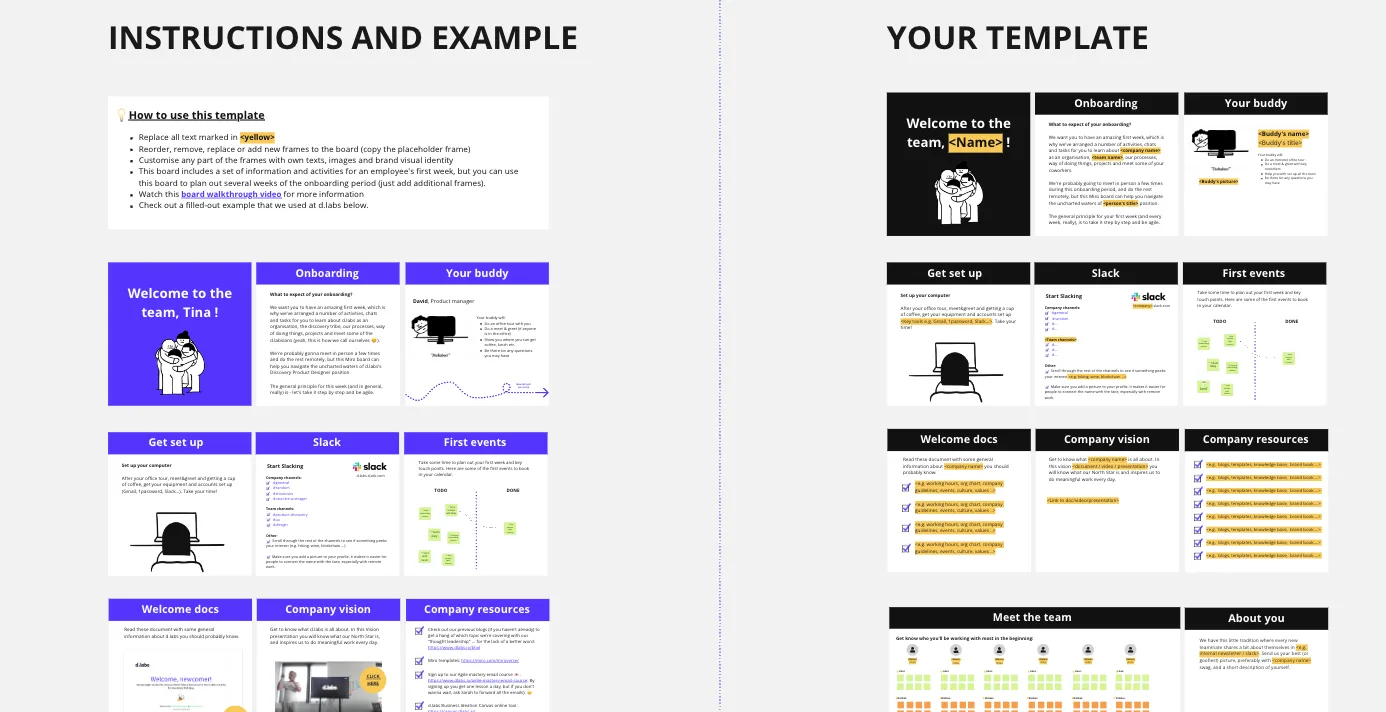
The Four C's: Compliance, Clarification, Culture, and Connection
To start, a robust onboarding strategy is built on the four C's, each serving as a cornerstone for a successful transition of new hires into productive and engaged employees. Here's how each component plays a crucial role, illustrated with real examples:
Compliance : This is the foundation of the onboarding process, ensuring that all legal and procedural requirements are met. For instance, a healthcare company might use this phase to verify professional licenses, complete HIPAA training, and ensure understanding of patient privacy laws. It's about making sure the new employee is fully aware of and compliant with industry regulations and company policies from day one.
Clarification : This step is about setting clear expectations and understanding of the new role. A tech startup, for example, might provide a detailed job description, a clear outline of project goals for the first quarter, and a roadmap of the product development cycle. This helps the new hire understand exactly what is expected of them, the scope of their role, and how they fit into the larger team and company objectives.
Culture : Immersing new hires in the company ethos is vital for their integration into the workplace. A company like Zappos, renowned for its culture, might include office tours that showcase their unique work environment, storytelling sessions where leaders share company successes and failures, and participation in community service events that reflect the company's core values. This C is about connecting new employees to the heart and soul of the organization, helping them feel a part of something bigger.
Connection : The final C is about building relationships. For example, a multinational corporation might pair new hires with a global mentor, involve them in cross-departmental projects, or host virtual meet-and-greets with team members from around the world. This not only helps new employees build their internal network but also fosters a sense of belonging and teamwork across the organization.
By focusing on each of these C's, companies can create an onboarding process that not only covers the basics but also sets up new hires for long-term engagement and success within the company.
How to create an onboarding process for new employees
After building a robust recruitment process , the next step is to map out the journey a new hire will embark upon. This section lays out a step-by-step guide, ensuring that from pre-boarding to ongoing support, your new employees are met with a structured and supportive transition into your company. Follow these steps to create an amazing employee onboarding process
Step 1: Pre-boarding – Laying the groundwork
Send a Welcome Email : As soon as a new hire accepts the job offer, send a warm welcome email detailing what they can expect next.
Share Company Culture : Provide a glimpse into your company culture through engaging content like videos, company mission statements, and testimonials from current employees. You can build the entire workflow and processes to be followed in a
process mapping tool like Miro.
Prepare for Arrival : Ensure all necessary paperwork is sent out and completed before the first day to streamline the administrative process.
Step 2: First day – Making a memorable entrance
Host an Orientation Session : Begin with a comprehensive orientation session that outlines the company's history, mission, and values.
Introduce the Team : Facilitate introductions with immediate team members and key personnel across the company.
Set Up the Workspace : Have the new hire's workspace fully prepared with all the tools and access they need to start working.
Step 3: Training and development – Investing in growth
Outline the Role : Clearly define the new hire's role, responsibilities, and expectations.
Provide Role-Specific Training : Offer in-depth training sessions tailored to the new hire's specific job functions.
Assign a Mentor : Connect the new employee with a mentor for guidance and support as they navigate their new role.
Step 4: Ongoing support – nurturing long-term success
Schedule Regular Check-Ins : Set up consistent meetings to provide feedback, answer questions, and discuss the new hire's progress.
Solicit Feedback : Encourage new hires to provide their input on the onboarding experience, using their insights to improve the process.
Foster Professional Development : Offer opportunities for further learning and growth, such as workshops, courses, or cross-training in other departments.
By following these steps, you can create a structured and effective onboarding process that supports new employees from the moment they join your company, helping them to become engaged and productive team members.
Tips to build a successful employee onboarding process
Now that you've laid out your entire onboarding process, let's move on to the final tips and best practices for mapping your employee onboarding journey.
Personalize the Onboarding Experience : Customize onboarding to fit individual needs, like a tech firm offering role-specific virtual reality tours for new developers.
Innovate with Engagement : Use gamification and interactive tools to keep the onboarding process fresh, such as a mobile app for scavenger hunts that familiarize new hires with the company.
Proactively Address Challenges : Implement strategies like buddy systems in remote setups to enhance engagement and ease the transition for new employees.
Measure and Refine : Track KPIs such as time-to-productivity to assess and continually improve the onboarding process, ensuring it aligns with long-term success metrics.
Your next step: Implementing excellence
Are you ready to transform your onboarding process? With expert guidance and a strategic approach, you can create an onboarding experience that resonates with new hires and lays the foundation for a thriving workforce.
Try out Miro for free and start designing a complete onboarding process. It also serves as a singular, reliable reference that your employees can consult as an all-encompassing guide as they embark on their new professional journey.
Get on board in seconds
Join thousands of teams using Miro to do their best work yet.
The Ultimate Guide to Employee Onboarding Process [2024]
- November 12, 2023
![staff onboarding journey The Ultimate Guide to Employee Onboarding Process [2023] (1)](https://images.blog.airmason.com/wp-content/uploads/2023/10/The-Ultimate-Guide-to-Employee-Onboarding-Process-2023-1.png)
Are you struggling with employees leaving your company shortly after joining, or taking too long to become productive? The solution might be a well-structured and effective onboarding process. In this blog post, we’ll dive deep into the employee onboarding process, explore its key components, discuss the role of HR, and offer practical tips to ensure a successful onboarding experience for your employees.
Key Takeaways
- Understanding the employee onboarding process involves creating an efficient experience that leads to better retention and performance.
- An effective onboarding process is comprised of pre-boarding activities, first day essentials, and ongoing support & development.
- HR professionals can use solutions to overcome common challenges in order to create a positive onboarding experience for remote employees.
Understanding the Employee Onboarding Process
A good employee onboarding process is more than just paperwork and basic orientation. It’s an entire process that starts before the employee joins the company and extends throughout their initial months of employment. An effective onboarding process helps new employees assimilate into the company’s culture, understand their roles, and receive on-the-job training, ultimately leading to employee satisfaction and long-term success.
The duration of the onboarding process may differ based on the company and the employee’s role. However, bear in mind that a new employee’s onboarding experience can significantly affect their performance and satisfaction. Both the new employee’s manager and the HR team should be involved in creating an efficient onboarding experience, one that spans from the prospective employee’s initial interaction with the company to their integration into the team and company’s processes.
A poor onboarding experience can lead to confusion, frustration, and even employee turnover, which is expensive and time-consuming for businesses. On the other hand, a good onboarding process sets clear expectations for the new hire, promotes open communication, and fosters a sense of belonging, ultimately leading to better employee retention and performance.
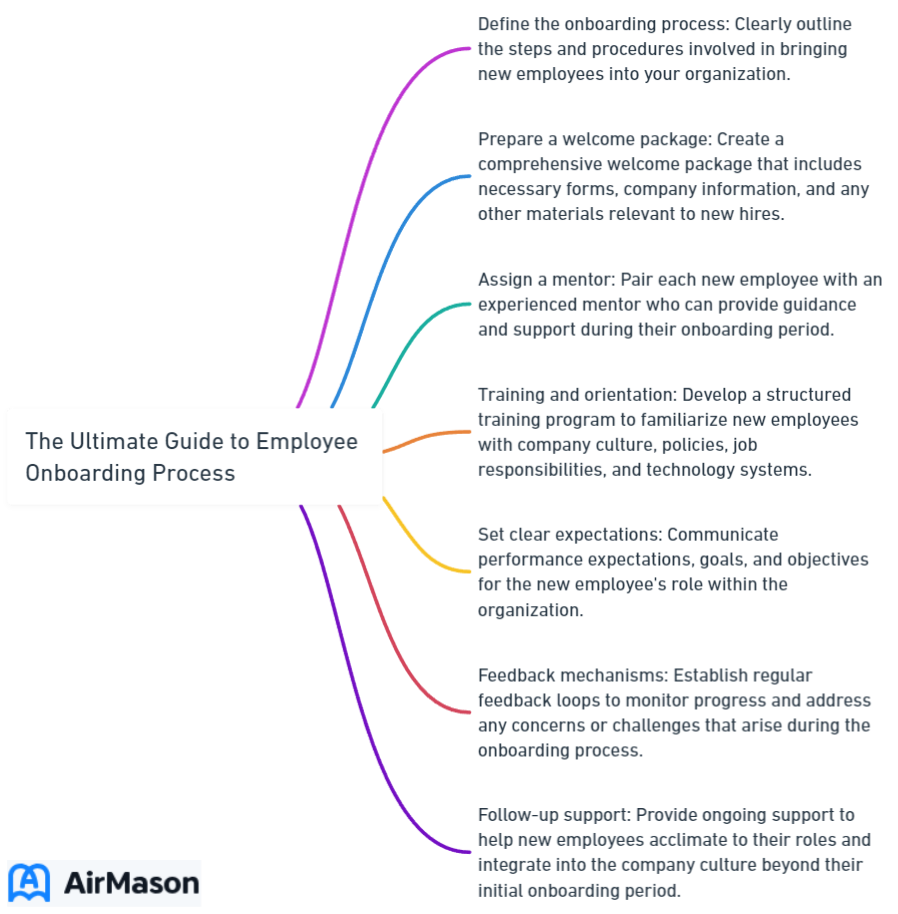
Key Components of an Effective Onboarding Process
A successful employee onboarding process involves three main components: pre-boarding activities, first-day essentials, and ongoing support and development. By following a comprehensive onboarding checklist, these components work together to create a positive onboarding experience that helps new employees feel welcomed and valued, while also ensuring they have the tools and resources needed to become productive members of the team.
Employee Onboarding
Employee onboarding is a critical process that sets the tone for a new hire’s experience within an organization. It encompasses the structured orientation and integration of a new employee into the company culture, policies, and their role responsibilities. A well-planned onboarding program not only familiarizes the employee with their job duties but also helps them understand the broader organizational goals and values. This process typically includes elements such as orientation sessions, introductions to key team members, training programs, and provision of necessary resources. Effective employee onboarding not only leads to quicker productivity but also fosters a sense of belonging and engagement, ultimately contributing to higher retention rates and overall organizational success. It’s a strategic investment in the long-term success of both the individual and the company.
Pre-Boarding Activities
Pre-boarding is the preparatory phase before a new hire’s first day of employment. It is an essential part of the employee onboarding process, as it helps facilitate a smoother transition for the employee when they join the company. Pre-boarding activities typically include sending welcome emails, providing company policies, and assigning tasks. A pre-boarding email should be accurately structured to include all crucial information related to the activity. Examples of such details may include dates, times, locations, contact info, instructions on what to bring and dress code. This email should be concise and pre-formulated to ensure consistency and clarity.
Beyond emails, there are several measures that can be taken prior to the new hire’s first day to ensure a smooth and welcoming transition. These include:
- Constructing an orientation agenda
- Establishing their salary account
- Furnishing the essential office supplies
- Appointing a mentor to assist the new hire in acclimating
- Allocating IT resources to the employee
- Providing basic training materials and an outline of the tasks to be accomplished via employee onboarding software
Proactive preparation for a new hire’s arrival by HR managers can pave the way for a successful onboarding experience, leaving a lasting, positive impression on the employee.
First-Day Essentials
The first day of work signifies a vital stage in a new employee’s onboarding journey. Crafting a memorable onboarding experience can make them feel welcomed, valued, and ready to excel in their new role. To achieve this, a combination of practical and engagement-focused activities should be planned for the first day.
Practical activities include providing employees with necessary hardware and software, having them sign relevant paperwork, and giving them a tour of the office. On the other hand, engagement-focused activities can involve ensuring clear communication, setting expectations, introducing new hires to the company culture and values, and facilitating their connection with colleagues and integration into the team.
Another key aspect of making a new employee’s first day successful is ensuring they have a clear agenda and know what to expect. Involvement of the new hire’s manager in the process can contribute to a memorable and positive experience on the first day of onboarding, given their significant role in the employee’s success.
Ongoing Support and Development
Although the initial days of onboarding set the tone for a new employee’s experience, providing ongoing support and development throughout their tenure is equally vital. Sustained support during the onboarding process can lead to enhanced performance, job satisfaction, and employee retention. This support may come in the form of on-the-job training, mentorship, and regular feedback from the employee’s manager.
Training plays an integral role in the onboarding process, helping new employees understand their roles and responsibilities and reducing the need for excessive hire paperwork. The success of training implementation largely depends on the support of the employee’s immediate manager, who should be actively involved in the process.
Additionally, a designated mentor or colleague can provide support and guidance to help the new employee acclimate to their new environment. This ongoing support, combined with a culture of open communication and regular feedback, can foster a sense of belonging and connection among employees, as well as augment employee engagement and productivity.
The Role of HR in Employee Onboarding

The human resources (HR) department is instrumental in the employee onboarding process, with responsibilities including:
- Issuing job offers
- Coordinating with other departments
- Offering training and orientation
- Providing the employee handbook
- Managing the entire onboarding workflow
- Ensuring that all required steps are completed promptly and efficiently.
Collaboration with other departments during the onboarding process is vital, benefiting both the department in which the individual will function and the departments they will coordinate with. This coordination ensures that all necessary information is shared, and resources are allocated effectively. During the onboarding process, HR generalists and the IT team may work together to provide HR orientations and equipment set-up, ensuring that employees have the tools they need to succeed in their new roles.
In addition to coordinating onboarding activities, HR is also responsible for managing the transition of current employees into new roles, a process known as crossboarding. By providing support and guidance during this transition, HR professionals can help ensure a smooth and successful experience for employees moving to new positions within the company.
What is Onboarding
“ What is onboarding ” is a critical process in the realm of human resources and organizational development. It refers to the structured approach taken by companies to integrate and orientate new employees into the workplace environment. This process encompasses a series of activities designed to familiarize newcomers with their roles, team members, and the company’s culture and policies. Effective onboarding not only provides essential information about job responsibilities but also sets the foundation for a positive employee experience. It typically involves a mix of formal training sessions, introductions to key personnel, and the distribution of relevant materials. Additionally, onboarding serves as a platform for establishing clear performance expectations and addressing any initial concerns or questions that new hires may have.
Benefits of a Well-Structured Onboarding Process

A well-structured onboarding process offers numerous benefits, including improved employee retention, faster time to productivity, and increased job satisfaction. By taking the time to create a comprehensive and effective onboarding process, companies can help new employees feel welcomed, supported, and prepared to contribute to the organization’s success.
One of the primary advantages of a well-structured onboarding program is enhanced employee retention. Employees who undergo a positive onboarding experience are more likely to stay with the company for longer periods. This can lead to cost savings for the organization, as hiring and training new employees can be a significant expense.
Another benefit of a well-planned onboarding process is the faster time to productivity. By providing new employees with the necessary tools, resources, and training, companies can help them quickly become productive contributors to the organization. This increased productivity can lead to improved overall performance and success for the company.
Implementing Technology in Onboarding
Leveraging technology in the employee onboarding process can streamline and enrich the experience for both employees and HR professionals. Incorporating technology, such as HR software and chatbots, can reduce the burden on HR personnel while providing new employees with a stimulating and optimized experience.
HR software, such as Hibobs, Boardon, and Freshteam, can be employed to automate tasks, track progress, and provide personalized onboarding experiences for each new hire. By utilizing onboarding software, HR managers can ensure that all required steps are completed promptly and efficiently, allowing them to focus on more strategic aspects of their role.
Chatbots can also play a significant role in the employee onboarding experience. They can be utilized to address employee inquiries and provide guidance during the onboarding process. For example, chatbots can be programmed to answer questions about company policies, helping new employees quickly become familiar with the organization’s processes and expectations.
Best Practices for Successful Employee Onboarding

For a successful employee onboarding process, adherence to best practices and implementation of strategies that welcome, support, and prepare new hires for success is necessary. Some of these best practices include:
- Aligning job descriptions with the actual roles and responsibilities of the position, ensuring clear expectations for new employees.
- Automating workflows and tasks within the onboarding process, reducing the administrative burden on HR personnel and ensuring all required steps are completed efficiently.
- Fostering a strong company culture that promotes open communication, collaboration, and a sense of belonging, helping new employees feel connected and engaged with the organization.
By implementing these best practices, companies can create an effective onboarding process that not only attracts and retains top talent but also helps new employees become productive members of the team.
Overcoming Common Challenges in Onboarding
Even with the best efforts of HR professionals, common challenges can surface during the onboarding process. Some of these challenges include:
- An abundance of paperwork
- A lack of understanding of roles and responsibilities
- An overload of information
- Expectations that may be difficult to meet
However, there are solutions to overcome these obstacles and create a positive onboarding experience.
To address role clarity, it’s crucial to:
- Clearly define and communicate the responsibilities and tasks associated with the role
- Provide a written schedule or timeline that outlines expectations and deadlines
- Encourage open communication and provide opportunities for new hires to ask questions and seek clarification.
To avoid information overload, consider drip-feeding necessary and relevant information gradually instead of overwhelming the employee with all the information at once. Present content in bite-size bits to facilitate easier digestion and retention of the information. Include only essential information during the first day on the job and share additional information over time as needed.
Measuring the Success of Your Onboarding Process
Tracking onboarding metrics is vital to assess and enhance the employee onboarding process. Metrics such as turnover rate, satisfaction, and training completion can provide valuable insights into the effectiveness of the onboarding process and help identify areas that may need optimization or revision.
By gathering feedback from new employees and analyzing the data, HR professionals can gain a better understanding of the onboarding experience and make necessary adjustments. Feedback scores from both new hires and managers can also be used as a key metric to evaluate the effectiveness of the onboarding process.
By correlating onboarding metrics and constructive 360 feedback, employees can recognize any additional training or support they may require for a successful onboarding experience. This continuous improvement approach ensures that the onboarding process remains effective and relevant, ultimately leading to better employee retention and performance.
Onboarding Employee Experience
The onboarding employee experience plays a pivotal role in setting the tone for a new hire’s journey within an organization. It encompasses the entire process of integrating a new team member, from the moment they accept the job offer to their first few months on the job. A well-structured onboarding program goes beyond administrative tasks; it provides a comprehensive introduction to the company culture, values, and expectations. This experience is designed to acclimate employees to their roles, foster a sense of belonging, and ensure they have the tools and knowledge needed to excel in their positions. Effective onboarding not only boosts productivity but also contributes to higher retention rates and increased job satisfaction. It is a crucial step towards building a motivated and engaged workforce, ultimately leading to organizational success.
Adapting the Onboarding Process for Remote Employees

With the prevalence of remote work, adapting the onboarding process to cater to remote employees becomes a necessity. Leveraging technology, maintaining clear communication, and fostering a sense of belonging and connection are crucial strategies for ensuring a successful onboarding experience for remote workers.
Technology such as:
- Video conferencing software
- Onboarding software
- Learning management systems (LMS)
- Communication tools
- Digital forms and documentation
- Online training platforms
- Virtual tours
can be utilized to provide a streamlined and engaging remote onboarding experience.
Setting clear expectations and communication guidelines, establishing distinct lines of communication, and emphasizing the resources available to the employees are essential for effective communication with remote employees during onboarding. Providing regular feedback and recognition, and ensuring that remote employees are included in team activities can also help foster a sense of belonging and connection.
In conclusion, a well-structured and effective employee onboarding process is essential for ensuring employee satisfaction, retention, and productivity. By understanding the key components of onboarding, leveraging technology, implementing best practices, and adapting the process for remote employees, companies can create a positive onboarding experience that sets new hires up for success. As the workforce continues to evolve, it’s crucial for organizations to continually evaluate and improve their onboarding processes to attract and retain top talent.
Frequently Asked Questions
What is the 4 step onboarding process.
The four-step onboarding process includes pre-boarding, orientation, training and integration, with eloomi providing customizable solutions for each phase to help new employees have a successful transition.
What is the onboarding process in HR?
Onboarding is an important HR process that helps new employees integrate into the organization. It includes activities such as completing administrative tasks, participating in a first-day orientation, learning about the organization’s structure, and understanding its culture, vision, mission, and values.
What are the 5 C’s of onboarding?
The 5 C’s of onboarding are compliance, clarification, confidence, connection, and culture – all essential components to ensure a successful and smooth onboarding experience.
How many days is onboarding?
Onboarding typically should take at least three months, with some HR experts recommending up to six months of onboarding for new hires. Extending the onboarding process throughout the employee’s first year can positively increase employee retention and engagement.
How long should the employee onboarding process last?
The employee onboarding process typically lasts for several months.
Tehsin Bhayani
AirMason was born when Tehsin was trying to create a digital culture book, but couldn’t find any solutions in the market that had all the features he needed. In 2016, AirMason officially launched. In five years, AirMason has created thousands of handbooks for more than 1,000 clients around the world.
Ultimate Onboarding Guide for New Employees in 2024
Employee on boarding: a comprehensive guide for 2024, press esc to close.
Optimizing the employee journey from onboarding to exit

The focus is slowly shifting to the employees, who are a company’s most valuable asset in today’s tough business world. Making the work experience better for employees helps businesses succeed and makes workplaces happy. This detailed guide looks at the what, why, and how of the employee journey and gives companies that want to get the most out of HRM useful tips.
Table of Contents
What is an employee journey, why is supporting the employee journey important, what is employee journey mapping, how to map an employee journey, the benefits of employee journey mapping, how to create a strong employee journey.
The employee journey includes every part of working for a company, from the first day of training to the last day of work and everything in between. It has many important stages, such as onboarding, growth, retention, and exiting. Each stage has its own opportunities and challenges. Planning and carrying out these events with care will make employees happier and more involved.
It’s helpful to think of this journey in phases:
- Awareness and recruitment : The potential employee learns about the company and applies for a position.
- Onboarding : The employee learns the ropes of the job and the company culture.
- Development : The employee receives training and opportunities to grow professionally.
- Retention : The company employs strategies to keep the employee satisfied and engaged.
- Exit : The employee leaves the company, ideally in a manner that maintains a positive relationship.
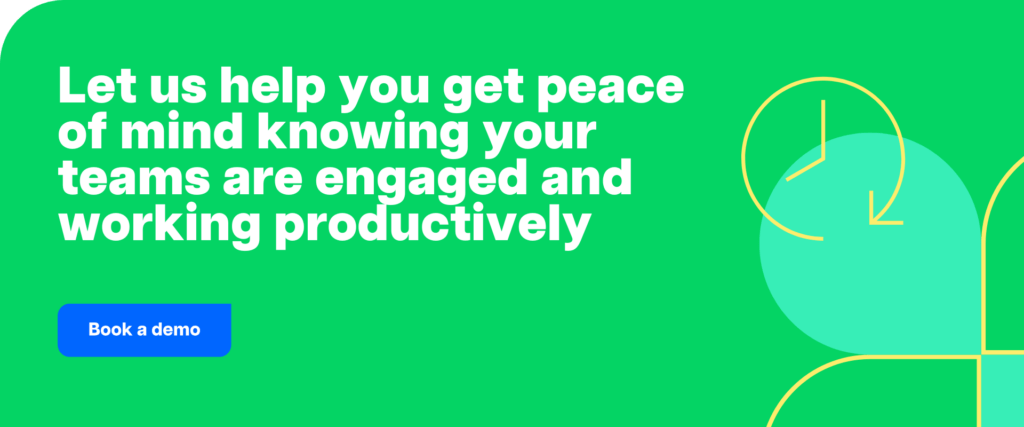
Investing in an employee journey that is well-supported is essential. It directly affects employee engagement and job happiness, two factors that are strongly related to higher production and better performance. Good working relationships strengthen the company’s employer brand, which attracts top personnel. To put it another way, employees are more likely to put in the time and effort required to finish their task and contribute to the success of the company when they feel valued and inspired.
The strategic process of recording the important events and phases of an employee’s career at a company is called employee journey mapping. With the use of this technique, crucial touchpoints where actions can have the biggest effects are identified. Organizations may ensure a smoother and more engaging work experience by better meeting the requirements and expectations of their employees by recognizing these moments.
An essential first step in comprehending and improving the whole employee experience in a company is mapping out the employee journey. Here’s a thorough examination of each stage of the procedure:
1. Gather data
Objective : Gather in-depth data to comprehend the present state of the employee experience from a variety of angles.
- Surveys : Send out surveys to collect quantitative information on a range of employee lifecycle topics, such as job satisfaction, role and responsibility comprehension, and management feedback.
- Interviews : To gather qualitative insights, do one-on-one interviews. These can go into great detail about topics including daily obstacles, workplace culture , and improvement recommendations.
- Observation : To find differences between stated experiences and actual practices, observe interactions and workflows in the workplace firsthand.
- Exit interviews : Examine exit interviews to find out why workers depart and to spot any patterns or reoccurring problems.
- Tools and techniques : To compile and analyze data, use digital technologies like HR analytics platforms, Zoom for virtual interviews, and SurveyMonkey for surveys.
2. Identify key touchpoints
Objective : Pinpoint critical moments in the employee journey that significantly impact their experience.
- Onboarding experience : The initial phase of training and integration into the company is crucial. Identifying elements that can be improved, such as mentorship programs or orientation sessions, can enhance new hire retention and satisfaction.
- Performance evaluations : These are pivotal in determining career progression and satisfaction. Identifying how these can be made more constructive and aligned with personal career goals is key.
- Employee milestones : Recognize and plan for career milestones, promotions, and role changes that are significant for employee growth .
- Support and recognition : Identify how support is provided in times of need and how achievements are recognized in the organization.
Mapping tools : Use journey mapping software like UXPressia or Microsoft Visio to visualize these touchpoints and their impact on the employee experience.
3. Analyze and plan
Objective : Utilize the insights gained to identify areas for improvement and develop strategic interventions.
- Data analysis: Break down the data collected to uncover trends, pain points, and opportunities.
- Strategic planning : Based on the analysis, develop plans to address the key areas. This might involve redesigning the onboarding process , revamping training programs, or introducing new employee recognition systems.
- Stakeholder involvement : Engage with stakeholders across the organization to ensure the planned changes align with broader business objectives and secure their buy-in.
Strategies : Employ tools like SWOT analysis to assess strengths, weaknesses, opportunities, and threats in the current employee experience.

4. Implement changes
Objective : Execute the planned initiatives aimed at enhancing identified touchpoints.
- Pilot programs : Test new initiatives in controlled environments to gauge effectiveness before a full rollout.
- Training and development : Implement new training programs or enhance existing ones to address gaps in skills or knowledge.
- Policy updates : Make necessary adjustments to HR policies to better support the workforce.
Implementation tools : Project management software like Asana or Trello can help coordinate and track the progress of implementation efforts.
5. Review and iterate
Objective : Continuously assess the impact of changes and refine the journey as needed.
- Feedback loops : Establish mechanisms to regularly gather feedback on recent changes to understand their impact and identify further areas for improvement.
- Performance metrics : Utilize HR metrics to track the outcomes of implemented changes, such as employee turnover rates , employee satisfaction scores, and productivity levels.
- Iterative improvement : Based on feedback and performance data, refine and adjust the initiatives. Consider establishing a continuous improvement team dedicated to the ongoing enhancement of the employee journey.
Review tools : Use data analytics platforms to monitor metrics and feedback tools like Officevibe for real-time employee sentiment analysis.
Mapping the employee journey is a dynamic process that requires continuous attention and adaptation to be effective. By systematically following these steps, organizations can create a more engaging and productive work environment tailored to the needs of their workforce.
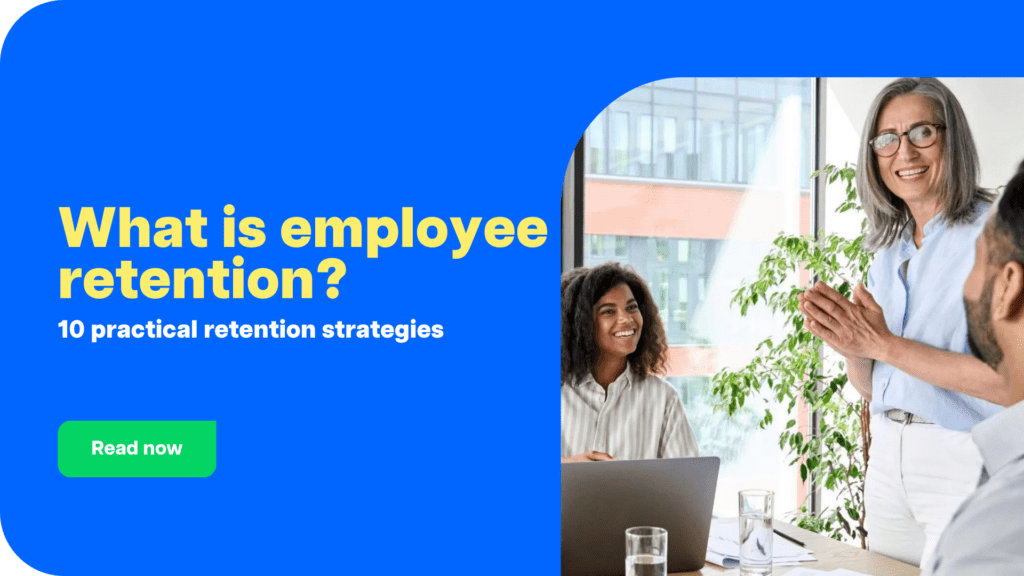
Employee journey mapping is a strategic tool that offers numerous advantages for organizations aiming to enhance their workplace culture and operational efficiency. Below are detailed benefits derived from effectively implementing employee journey mapping.
Enhanced employee insights
Objective : Gain a deeper understanding of employee needs, expectations, and behaviors.
- Better understanding of employee lifecycle : Mapping the journey helps HR and management understand each phase of the employee experience, from onboarding to exit. This holistic view reveals how employees interact with various aspects of the organization and where they might encounter issues.
- Identifying patterns and trends : With comprehensive data, organizations can identify common patterns and trends in employee behavior. For example, if multiple employees find a particular training module unhelpful, revisions can be targeted to enhance effectiveness.
- Tailored solutions : Insights into individual and group experiences allow for more personalized HR strategies, catering to diverse employee needs and improving overall job satisfaction.
Impact : These insights can lead to more effective HR policies and a more supportive workplace environment, reducing misunderstandings and enhancing mutual respect between staff and management.
Improved engagement
Objective : Increase employee engagement and satisfaction by addressing critical moments effectively.
- Addressing pain points : Organizations can greatly improve employee morale and job satisfaction by comprehending and improving key touchpoints in the employee experience. This can entail streamlining administrative procedures, improving channels of communication, or offering improved assistance during periods of high workload.
- Fostering a positive work environment : When employees perceive that their input is actually resulting in tangible changes, they are more likely to feel appreciated and involved. They have better daily experiences as a result, and their dedication to the company is strengthened.
- Increasing job satisfaction : Job satisfaction and engagement are intimately related. Engaged workers are more likely to report being happier in their jobs, which can boost output and reduce attrition .
Impact : Higher engagement levels are often reflected in increased productivity and better quality of work, directly benefiting the company’s bottom line.
Strategic improvements
Objective : Implement targeted interventions for more meaningful changes, impacting retention and productivity positively.
- Data-driven decision making : Employee journey mapping provides data that can be used to make informed decisions about where to allocate resources for the biggest impact on employee satisfaction and organizational efficiency.
- Enhancing retention rates : By improving critical aspects of the employee experience, organizations can reduce turnover. Employees are more likely to stay with a company that actively works to improve their workplace experience and shows a commitment to their professional growth.
- Boosting productivity : Optimized processes and improved engagement lead to higher productivity. Employees who have clear career paths, adequate support, and recognition are more productive and contribute positively to organizational goals.
Impact : Through increased productivity and retention, employee journey mapping-based strategic enhancements not only improve individual employee outcomes but also propel corporate success.
Employee journey planning has numerous, significant advantages. The practice contributes to the development of a more adaptable and long-lasting company by helping to improve engagement, obtain insightful knowledge about employee experiences, and make strategic adjustments. Companies that prioritize the employee experience not only improve their internal culture but also establish themselves as appealing employers in the highly competitive job market.
Creating a strong employee journey enhances workplace satisfaction and retention. Here are concise strategies to achieve this:
Flexible onboarding programs
- Customization : Tailor onboarding to fit the roles and experiences of new hires.
- Mentorship : Include mentorship to help newcomers integrate smoothly.
- Pace adjustment : Allow employees to progress at their own comfortable pace.
Continuous learning and development
- Career pathways : Offer clear career advancement opportunities and relevant training.
- Skill upgrades : Provide access to the latest industry-related training and workshops.
- Cross-functional training : Encourage learning across different business areas to broaden understanding.
Regular feedback loops
- Scheduled reviews : Conduct regular performance evaluations for open discussions on progress and goals.
- 360-degree feedback : Incorporate thorough input from all organizational levels.
- Real-time feedback : Encourage a culture in which exchanging constructive criticism is a regular part of dealings.
Recognition and reward systems
- Performance-based rewards: To acknowledge exceptional performance, give bonuses and promotions.
- Non-monetary recognition : Use non-monetary methods of gratitude, such as extra days off or public recognition.
- Personalized rewards : Tailor prizes to each recipient’s tastes to increase their worth.
By putting these techniques into practice, you can create a dynamic and encouraging work environment that matches employee development with organizational success and increases productivity and job satisfaction in general.
Enhancing workflows and HR procedures is only one aspect of optimizing the employee experience; another is building a vibrant ecosystem that supports employees’ development and success. Organizations can greatly increase overall performance and employee happiness by comprehending and proactively enhancing each step of the employee experience. This is where the road to employee greatness starts. Is your company prepared to take it?
View a free demo of Time Doctor

Andy is a technology & marketing leader who has delivered award-winning and world-first experiences.
Nike CEO claims remote work hindered Nike’s bold innovations
Dropbox ceo is fully embracing ai and remote work, related posts, achieve efficient customer support by integrating these powerful tools, empowering ai to improve customer service, implementing flexible work arrangements to reduce turnover, blending ai with human innovation for call center excellence, 10 benefits of flexible scheduling for employee retention and well-being, 10 proven tips to enhance team work-life balance and boost engagement.
6 tips to improve onboarding for new employees
.png)
How to improve onboarding? Make it visual
Effective onboarding is crucial for organizations to make sure new employees feel welcomed, supported, and equipped to succeed in their roles.
In this blog post, we'll explore the importance of a human-centered and holistic onboarding process and provide practical tips to enhance the onboarding experience for new hires.
Why new employee onboarding is important
Before diving into the tips, let's address the question, "What's in it for me?" New employee onboarding offers several benefits.
Increased productivity
Well-structured onboarding programs help new hires become productive faster, reducing the time it takes for them to contribute to the organization's goals.
Improved retention
A positive onboarding experience fosters a sense of belonging and engagement, increasing the likelihood that new employees will stay with the company long-term.
Enhanced job satisfaction
When new hires feel supported and have a clear understanding of their roles and responsibilities, they're more likely to experience job satisfaction and perform at their best.
What a good onboarding process looks like
To create an effective onboarding process, it's essential to consider the four Cs of onboarding, as defined by the SHRM Foundation:
- Compliance : Make sure new employees understand and follow legal and regulatory requirements related to their roles.
- Clarification : Provide clear expectations, goals, and performance metrics to help new hires understand their responsibilities and how they contribute to the organization's success.
- Connection : Foster relationships and connections between new employees and their colleagues, managers, and mentors to create a supportive network.
- Culture : Introduce new hires to the organization's values, mission, and culture, helping them align their behaviors and actions accordingly.
6 Tips for improving onboarding for new employees
1. design a plan for each key phase of onboarding.
Create a structured roadmap that outlines the activities and information new employees need to know before their first day, during their first week, first 90 days, and first year. This plan should be comprehensive and tailored to the organization's specific needs.
Designing a plan for each key phase of onboarding involves breaking down the onboarding process into specific stages and outlining the activities, resources, and goals for each phase.
Here are some concrete ways to design a plan for each key phase of onboarding:
Before the First Day:
- Send a welcome email or package to new hires, including important information such as their start date, dress code, and any pre-employment paperwork.
- Provide access to necessary systems, tools, and resources, such as email accounts, project management software, or training materials.
- Assign pre-reading or pre-training materials to familiarize new hires with the company's culture, values, and policies.
- Schedule a comprehensive orientation session to introduce new hires to the organization's mission, vision, and values.
- Conduct a tour of the office or a virtual office tour, highlighting key areas and introducing new hires to their colleagues.
- Assign a buddy or mentor to guide new hires through their first day, answer questions, and provide support.
First Week:
- Provide an overview of the team's structure, roles, and responsibilities, including introductions to key team members.
- Offer training sessions or workshops on essential tools, processes, and systems used within the organization.
- Assign small projects or tasks to allow new hires to apply their skills and gain hands-on experience.
First 90 Days:
- Set clear goals and expectations for new hires, outlining what they should achieve within the first 90 days.
- Schedule regular check-ins with managers or mentors to provide feedback, address concerns, and offer guidance.
- Offer opportunities for new hires to attend team meetings, cross-functional sessions, or training programs to broaden their understanding of the organization.
First Year:
- Conduct performance reviews or evaluations to assess new hires' progress and provide constructive feedback.
- Offer opportunities for professional development, such as training programs, workshops, or conferences.
- Encourage new hires to set long-term goals and create a career development plan.
When designing the plan for each phase, consider the specific needs and goals of your organization. Tailor the activities and resources to align with your company's culture, values, and industry. Additionally, ensure that the plan is flexible enough to accommodate individual differences and adapt to changing circumstances.
Remember, the key is to provide a structured and comprehensive roadmap that guides new hires through their onboarding journey, ensuring they have the necessary information, support, and resources to succeed in their roles.
2. Build out your onboarding in your team's everyday tools
Use project management tools, HR management systems, or visual work platforms like Mural to centralize and streamline the onboarding process. This makes sure that all relevant information and resources are easily accessible to new hires.
When building out an onboarding program with your people operations team, it's important to consider using the right tools to streamline and enhance the onboarding experience. Here are some tools you should consider and why they can be beneficial:
HR management systems
HR management systems, such as BambooHR, Workday, or Namely, provide a centralized platform to manage employee data, automate administrative tasks, and track onboarding progress. These systems allow you to efficiently handle paperwork, track employee information, and ensure compliance with legal and regulatory requirements.
Project management tools
Project management tools like Asana, Trello, or Monday.com can be useful for organizing and tracking the various tasks and activities involved in the onboarding process. These tools enable you to create checklists, assign tasks to team members, set deadlines, and monitor progress, making sure that nothing falls through the cracks during the onboarding journey.
Visual collaboration platforms
Visual work platforms, such as Mural and Microsoft Teams , provide virtual spaces for teams to collaborate, brainstorm, and share information. These platforms can be used to create interactive onboarding materials, facilitate virtual meet-and-greets, and encourage collaboration among new hires and their colleagues.
Learning management systems (LMS)
LMS platforms can be valuable for delivering and tracking training materials and courses during the onboarding process. These systems allow you to create and distribute interactive training modules, quizzes, and assessments, providing that new hires receive the necessary knowledge and skills to excel in their roles.
Communication and messaging tools
Effective communication is crucial during the onboarding process. Tools like Slack , Microsoft Teams, or Google Chat provide instant messaging, video conferencing, and file-sharing capabilities, enabling seamless communication and collaboration between new hires, their managers, and team members. These tools foster real-time communication, making it easier to address questions, provide feedback, and build connections.
Employee onboarding software
Dedicated employee onboarding software can streamline and automate the onboarding process. These tools offer features like personalized onboarding workflows, automated task assignments, and interactive employee portals, providing a consistent and engaging onboarding experience for new hires.
When selecting tools for your onboarding program, consider factors such as ease of use, integration capabilities with existing systems, scalability, and cost.
3. Visualize important workflows and team processes
Visual representations, such as flowcharts, diagrams, or process maps, provide a clear and concise overview of how workflows and processes function. They break down complex information into easily digestible visual elements, making it easier for team members to understand the steps, dependencies, and interactions involved. Visuals eliminate ambiguity and make sure everyone is on the same page, reducing misunderstandings and errors.
Related: Visual Collaboration: What It Is & How To Get Started
Read on to see why visual collaboration is the key to unlocking outstanding onboarding experiences.
4. Build company culture into your onboarding
Incorporate activities, such as team-building exercises, virtual meet-and-greets, or storytelling sessions, to introduce new hires to the organization's culture. This helps them feel connected and aligned with the company's values and mission.
Here are some tangible ways to incorporate company culture into your onboarding:
Welcome package
Create a welcome package for new hires that includes items representing your company culture, such as branded merchandise, company values cards, or a welcome letter from the CEO. This sets the tone and introduces new hires to the unique aspects of your culture from the start.
Culture presentation
Dedicate a portion of the onboarding program to a culture presentation. This can be delivered by a senior leader or a representative from the people operations team. The presentation should cover the company's mission, vision, values, and key cultural aspects. Use real-life examples and stories to illustrate how these values are lived within the organization.
Culture handbook
Develop a culture handbook or guide that provides an in-depth overview of your company's culture. Include information about the history, values, rituals, and traditions that shape your organization. This handbook can serve as a reference for new hires to understand and align with the company culture.
Cultural immersion activities
Incorporate interactive activities into the onboarding process that allow new hires to experience and engage with the company culture. This can include team-building exercises, group discussions, or role-playing scenarios that reflect the values and behaviors you want to promote.
Mentorship and buddy programs
Pair new hires with mentors or buddies who embody the company culture. These mentors can guide new hires, answer questions, and provide insights into how the culture is lived day-to-day. Encourage mentors to share personal experiences and stories that highlight the importance of culture within the organization.
Cross-functional introductions
Facilitate introductions and interactions between new hires and employees from different teams or departments. This exposes new hires to a diverse range of perspectives and allows them to witness how the company culture is manifested across various functions.
Culture ambassador sessions
Organize sessions where employees from different levels and roles share their experiences and perspectives on the company culture. These sessions can be in the form of panel discussions, Q&A sessions, or informal coffee chats. This provides new hires with multiple viewpoints and reinforces the importance of culture throughout the organization.
Ongoing culture integration
Ensure that the company culture is consistently reinforced beyond the onboarding process. Incorporate culture-related activities, events, or initiatives into regular team meetings, performance reviews, and company-wide communications. This helps new hires see that culture isn't just a one-time introduction but an integral part of the organization's DNA.
Remember, building company culture into your onboarding process requires a holistic approach that combines both formal and informal methods. It's important to create an environment where new hires feel welcomed, engaged, and empowered to embrace and contribute to the company culture from Day One.
5. Use templates to scale team onboarding
Develop standardized templates for onboarding materials, such as welcome emails, training materials, and checklists. This provides consistency and saves time when onboarding multiple new hires.
With Mural, you can scale your onboarding capacity, and provide the most engaging experience possible for new employees, regardless of their location.
Here are a few ways (including free templates) to use Mural’s visual work platform to enhance your onboarding process.
Onboarding checklist
Create a checklist template in Mural to outline the key tasks and activities that new hires need to complete during their onboarding journey. This template can include items such as paperwork, training modules, introductions to team members, and setting up necessary tools and systems. New hires can mark off completed tasks, providing a visual representation of their progress.
One fun way to do this is with the Mural road trip onboarding template, which visualizes the onboarding process as a trip across country.

New hire welcome mural
Design a welcome mural to introduce new hires to the company, team members, and important resources. Include sections for personal introductions, team information, company values, and links to relevant documents or websites. This template encourages new hires to engage with their colleagues and explore the available resources.
Team introduction mural
Create a team introduction template in Mural to facilitate virtual introductions between new hires and their team members. Include sections for team member profiles, roles and responsibilities, and fun facts. This template helps new hires familiarize themselves with their team and encourages interaction and connection.
Onboarding timeline
Design an onboarding timeline template in Mural to visually represent the duration and sequence of onboarding activities. Include milestones, deadlines, and key events. This template provides new hires with a clear overview of what to expect during their onboarding journey and helps them stay organized and on track.
Training and resources hub
Create a training and resources hub template in Mural to centralize all the training materials, resources, and links that new hires need. Include sections for training modules, videos, documents, and FAQs. This template serves as a one-stop-shop for new hires to access the information and materials they need to learn and succeed in their roles.
Virtual meet-and-greet
Design a virtual meet-and-greet template in Mural to facilitate introductions and interactions between new hires and their colleagues. Include sections for icebreaker questions, fun facts, and discussion topics. This template encourages engagement and helps new hires build connections with their teammates.
A great way to structure this for distributed teams is to use the Mural world map template — have everyone put their photo over their location, and share something cool about where they live.

Feedback and reflection mural
Create a feedback and reflection mural to gather feedback from new hires about their onboarding experience. Include sections for feedback on the process, training, and overall experience. This template allows new hires to share their thoughts, suggestions, and concerns, enabling continuous improvement of the onboarding program.
Remember, Mural is a highly customizable platform, and you can adapt these templates to fit your specific onboarding needs. You can also explore the Mural template library for additional templates and inspiration.
6. Check in at key milestones and get feedback on the onboarding process
Regularly assess the effectiveness of your onboarding process by seeking feedback from new employees. Conduct check-ins at key milestones to address any concerns, provide additional support, and make necessary adjustments to improve the onboarding experience.
Why visual work is the secret to a great onboarding experience
Visual work plays a crucial role in enhancing the onboarding experience and facilitating connection between new hires. Here's how.
Simplifies complex information
Onboarding often involves a lot of information, including company policies, procedures, team structures, and workflows. Visualizing this information through diagrams, flowcharts, or infographics helps simplify complex concepts and makes them easier to understand. Visual representations provide a clear and concise overview, allowing new hires to grasp the big picture quickly.
Enhances comprehension and memory retention
Visuals have been proven to enhance comprehension and aid in information retention. When new hires can see the information presented visually, it helps them process and remember it more effectively. Visuals engage different parts of the brain, making the information more memorable and increasing the likelihood of retention.
Promotes active participation
Visual work encourages new hires to actively engage with the onboarding process. By involving them in creating or interacting with visual materials, such as collaborative whiteboards or interactive presentations, new hires become active participants rather than passive recipients of information. This active participation fosters a sense of ownership and investment in their own onboarding journey.
Facilitates collaboration and connection
Visual work provides a platform for new hires to collaborate with their colleagues and build connections. For example, using collaborative whiteboard tools like Mural allows new hires to contribute ideas, share insights, and work together on visualizing team processes or brainstorming sessions. This collaborative environment promotes interaction, encourages teamwork, and helps new hires establish connections with their peers.
Supports multimodal learning
Visual work caters to those who are visual learners. By incorporating visual elements into the onboarding process, organizations can accommodate diverse learning preferences and make sure that new hires receive information in a way that resonates with them. This inclusivity promotes a more effective and personalized onboarding experience.
Creates a lasting impression
Visuals have a lasting impact on individuals. When new hires encounter visually appealing and well-designed materials during their onboarding, it leaves a positive impression and reinforces the organization's commitment to a thoughtful and engaging onboarding process. This positive experience contributes to their overall satisfaction and engagement with the company.
By incorporating visual elements into the onboarding process, organizations can create a more engaging, memorable, and effective onboarding experience for new hires.
Set the stage for your new employees with successful onboarding
By implementing these tips, organizations can create a human-centered and holistic onboarding process that sets new employees up for success. Remember, a well-designed onboarding experience not only benefits the new hires but also contributes to the overall growth and success of the organization.
Investing in a human-centered onboarding process is crucial for organizations to maximize the potential of their new hires. By leveraging tools like Mural, organizations can streamline and enhance the onboarding experience, fostering a sense of belonging for new team members.
About the authors

Bryan Kitch
Tagged Topics
Related blog posts

Visual collaboration: What it is & how to get started

Welcome to Mural: how to get your team started

How to Improve Company Culture: A Step-by-Step Guide
Related blog posts.
%20(3).jpg)
A guide to the Agile development lifecycle

Team collaboration software: A buyer’s guide

How to plan and organize a workshop
- Business Essentials
- Leadership & Management
- Credential of Leadership, Impact, and Management in Business (CLIMB)
- Entrepreneurship & Innovation
- Digital Transformation
- Finance & Accounting
- Business in Society
- For Organizations
- Support Portal
- Media Coverage
- Founding Donors
- Leadership Team

- Harvard Business School →
- HBS Online →
- Business Insights →
Business Insights
Harvard Business School Online's Business Insights Blog provides the career insights you need to achieve your goals and gain confidence in your business skills.
- Career Development
- Communication
- Decision-Making
- Earning Your MBA
- Negotiation
- News & Events
- Productivity
- Staff Spotlight
- Student Profiles
- Work-Life Balance
- AI Essentials for Business
- Alternative Investments
- Business Analytics
- Business Strategy
- Business and Climate Change
- Design Thinking and Innovation
- Digital Marketing Strategy
- Disruptive Strategy
- Economics for Managers
- Entrepreneurship Essentials
- Financial Accounting
- Global Business
- Launching Tech Ventures
- Leadership Principles
- Leadership, Ethics, and Corporate Accountability
- Leading Change and Organizational Renewal
- Leading with Finance
- Management Essentials
- Negotiation Mastery
- Organizational Leadership
- Power and Influence for Positive Impact
- Strategy Execution
- Sustainable Business Strategy
- Sustainable Investing
- Winning with Digital Platforms
A Guide to Employee Journey Mapping

- 08 Dec 2022
A business is only as strong as its employees—a sentiment that’s top of mind for human resources professionals and people managers amid mass resignations.
As the so-called “Great Resignation” has employees leaving jobs at chart-topping rates , you not only need to retain existing employees but compete with other organizations for top talent.
One way to proactively identify areas for improvement and create value for existing and prospective staff members is through employee journey mapping. Here’s a primer on what it is and how to leverage it to create value.
Access your free e-book today.
What Is Employee Journey Mapping?
Employee journey mapping is the process of visualizing the employee experience from hire to exit. Its goal is to determine areas for improvement and opportunities for value creation so you can retain and attract stellar employees and motivate them to do their best work.
Benefits of the employee journey mapping process include:
- Visualizing each employee’s experience at your company
- Illuminating holes or areas for improvement in your current employee experience
- Enabling more accurate job descriptions
- Informing budget allocation for initiatives that boost retention and engagement
Each of these helps increase employee satisfaction—thus increasing their motivation and quality of work —and your company’s competitive edge in the talent search.
To understand how to use the employee journey map to create value for employees, first explore the basics of value creation.
The Basics of Value Creation
In the online course Business Strategy , Harvard Business School Professor Felix Oberholzer-Gee explains how to create value using a tool called the value stick.

The value stick has four components:
- Willingness to pay (WTP) : The maximum amount a customer is willing to pay for a company's goods or services
- Price : The actual price of the goods or services
- Cost : The cost of the raw materials required to produce the goods or services, or employee compensation
- Willingness to sell (WTS) : The lowest amount suppliers are willing to receive for raw materials, or the minimum employees are willing to earn for their work
There are two ways to gain a competitive edge and attract the best talent: Offer higher compensation (raise the employee’s cost) or make the job more attractive (lower the employee’s WTS).
Lowering an employee’s WTS means they’re willing to accept less compensation. To do this, you need to make the job more attractive and create value.
Value creation not only pays off in terms of employee retention; it can impact the customer experience, too.
“In many services businesses, there’s a strong link between WTS and WTP,” Oberholzer-Gee says in Business Strategy . “By lowering WTS—by making work more attractive—we increase employee engagement, and this then leads to better customer experiences.”
Here are five steps to leverage employee journey mapping to create value.
Related: A Beginner’s Guide to Value-Based Strategy
How to Leverage Employee Journey Mapping to Create Value: 5 Steps
1. define and select employee type.
The first step in the employee journey mapping process is defining employee types, or personas, and selecting which to map first.
If your organization has many roles, you should map a journey for each persona; for example, an “entry-level data analyst” or a “new-hire mid-level marketing manager.”
Some parts of the process will be the same for all employees; others will vary based on job function and level.
2. Map the Employee Journey
The next task is documenting the selected persona’s journey throughout their time at your organization. This can be done in a list format or by drawing a timeline and mapping the journey visually.
This step requires thorough brainstorming to account for as many aspects of the persona’s experience as possible.
It can be helpful to think of the persona’s experience in stages. Use the following example, and tweak it to fit your organization:
- Hiring stage: From job posting to signed offer letter
- Onboarding stage: From day one to ramped up and fully acclimated
- Development stage: Developing skills while performing daily responsibilities
- Progression stage: Opportunities to advance their career within the company
- Offboarding stage: From resignation letter to exit interview
Some organizations operate on a strict schedule for role progression. If this applies to yours, use time as map markers instead of process stages. For instance:
- Before the first day
- One year in
- Two years in
- Eventual offboarding
After defining map markers, list each persona’s planned experience for each stage. This may seem daunting, given the number of factors that influence the employee experience. To make it easier, start by listing processes already in place.
For instance, under the “onboarding stage,” you could list:
- Receive a laptop and a company ID card
- Gain access to email, the project management system, and necessary accounts
- Go on an office tour
- Attend mandatory training
Next, list any added social or culture-building aspects of the experience, such as:
- Receive a company-branded T-shirt and a water bottle on the first day
- Get treated to lunch by the manager and team during the first week
- Attend meet-and-greets with senior leadership and members of each team
More in-depth journey maps include a list of resources needed to make each line item possible—for instance, the platform to conduct onboarding training or a budget for lunches with new hires.
While not every interaction can be documented, each step of the employee journey is important to their overall experience at your company and, ultimately, whether you retain them.
During this process, you may realize there are holes in the journey maps for some roles; for instance, if you don’t currently have practices in place for the development or progression stages. Note these so you can use them in step four when identifying value-creation opportunities.
3. Factor in Employee Feedback
Gathering employee feedback is a general best practice, but it can also play a useful role in assessing current employee journey maps.
There are many options for gathering feedback, including anonymous surveys, private interviews, and physical or virtual suggestion boxes. Other valuable sources of insight include exit interviews with people who leave your company and online reviews from current or former employees on sites like Indeed and Glassdoor .
Map employee feedback to the specific stage or time frame it applies to and notice patterns that emerge. Which stages have the most positive or negative feedback? Are there any general sentiments that could be addressed in a specific stage?
For example, perhaps you observe that employees commonly note in their exit interviews that their job description didn’t match up with their day-to-day tasks. In such cases, you can map that feedback to the hiring stage and use it to create job listings that more accurately reflect roles’ responsibilities.
4. Identify Value Creation Opportunities
Once you’ve mapped the persona’s journey and tracked feedback to each stage, identify areas for value creation. Remember that the two ways to create value for employees are increasing compensation (raising their cost) or making the job more attractive (decreasing their WTS).
Opportunities for value creation can include:
- Holes in the employee journey: Are you providing enough support during the onboarding process? Are professional development opportunities available? Is there a pathway for career advancement within your company for each role?
- Feedback about specific benefits: Benefits can include typical perks (such as vacation time and wellness budgets) or intangibles (like an increased sense of control or flexibility of work location or schedule).
5. Revise the Journey Map
Once you’ve identified opportunities to create value, prioritize and apply them. This can be a long process requiring budget allocation and organization-wide shifts.
Once changes have been implemented, revise the journey maps to include new elements. After you’ve gone through the process once, you can periodically reassess and update the journey maps to adapt to employees’ changing needs and values.

Creating Value for Employees
Creating a competitive employee experience is vital to any business strategy . Without strong, satisfied employees, no organization can reach its goals.
Armed with knowledge of the value stick and the employee journey mapping framework, you can create meaningful value for your employees and attract new ones.
If you’re interested in diving deeper into value creation, consider taking Oberholzer-Gee’s course, Business Strategy . It’ll equip you with a broader picture of how to factor the employee experience into your overall business strategy to create value for your customers, firm, employees, and suppliers to achieve success.
Want to learn more about how to create value for employees? Explore Business Strategy , one of our online strategy courses , to gain the skills to create organizational value. Not sure which course is the right fit? Download our free flowchart .

About the Author
- Utility Menu
Harvard Library HR
Onboarding employees can be done with a mixture of on-site and virtual experiences. This page is a comprehensive step-by-step guide to orienting employees, starting from before their first day through their first 90 days at the Harvard Library.
Virtual Course: Onboarding for Belonging and Retention (Library Staff)
Before the Employee's First Day
Allow adequate time between making the offer and the first day of work. From the time all required information is submitted to HR, it can take up to two weeks before the employee can be systems-ready.
Many arrangements have to be made to make sure that a new employee’s first day on the job is a happy and productive one. Consider:
- It may take time to secure and set up a workspace for the employee.
- You’ll want to thoughtfully plan their training schedule, which may involve scheduling meetings for them with busy people.
Designate a workspace for the new employee, and furnish it if necessary. If the employee will have a hybrid schedule, discuss flexwork office spaces and how to reserve a room.
Complete the HL/HCL Employee Onboarding Form to order computers, and secure a telephone line if needed.
Make arrangements for ID-card swipe access, and order any keys the employee will need to access work areas.
Make sure basic office supplies are already at the employee’s desk.
Order business cards if applicable.
Ensure that the person will have access to the systems and equipment they will need, including shared electronic file storage, financial tools, and collaboration systems.
Schedule meetings with key people who will help to orient the employee to their new position. Consider possible meet-and-greet meetings on site and/or virtually.
Consider asking for a peer mentor/buddy to act as a resource for the new employee. This would be someone who will be available at an informal level and will occasionally check in on the new employee. The volunteer could even take the new person on a tour. Creating a bond with someone on their new team can give the new employee a greater sense of belonging. Make sure to arrange with the volunteer in advance, and introduce them to the new employee on their first day.
Make sure the new hire knows where and when to report on their first day and whom they should check in with.
Encourage the new employee to register for a New Employee Welcome & Orientation session on HARVie.
On the Employee's First Day
Schedule an informal meet-and-greet to welcome the new employee.
Make sure the employee gets a tour of the building and campus, including locations of break rooms, restrooms, mailbox, recycling and trash, and an overview of security and emergency procedures. Show the employee where they can store personal belongings, and review any protocols related to food in the office.
A virtual tour of HL could be as simple as navigating through the HL Staff Portal and where they can find, for example:
- Staff events
- Zoom backgrounds
- Presentation templates
- Email signatures
- Library profile information
Meet with the employee 1:1 in a confidential environment. Discuss your expectations of each other in the upcoming week, probe to ask if they have any questions or concerns, and let them know the best way to reach you if they have questions or need any assistance.
Connect the employee with an IT customer service rep for computer and email setup, and, if applicable, help them set up their voicemail.
During the Employee's First Week
Help your new employee understand their role by showing them how their job relates to the larger organizational structure of your department or business unit.
Ensure the employee understands time-reporting responsibilities and local procedures on reporting time and absences.
Review any local procedures on phone-answering , message-taking, handling calls from the press, etc.
Review the location, instructions on use, and where to find supplies for office equipment such as the printer, copier and fax.
Review department-specific websites , shared drives, listservs, journal subscriptions, library access, etc., as well as software programs — create a learning plan for any needed software skills.
During the Employee's First Month
Meet with your new employee to do some goal-setting . You will be reviewing your employee around the 90-day mark, so this is a good timeframe for goals that you set with them. It’s important to enlist the staff member in formulating and assessing the goals that you set together. These should include not only deliverables and project deadlines, but also learning goals that will help to build the capacity of your employee to offer more and more value over time.
One of the goals of your initial meetings with your staff member is to identify any technical or professional skills that your staff member will need in order to be successful in their new role, and create a learning plan with them if needed.
Before the Employee's 90-Day Mark
Schedule an orientation and review meeting with your employee to give them some feedback about their performance and complete the 90-Day Orientation and Review Form .
With the exception of union members who are transferring from other units within Harvard, the first 90 days are the orientation and review period. Read more about this period as it pertains to non-union employees and HUCTW employees (personnel manual, page 15).
- Offboarding
- Universal Manager Training
- Position Change / Review
- Gifts & Bonuses
- Managing Leaves of Absence
Root out friction in every digital experience, super-charge conversion rates, and optimise digital self-service
Uncover insights from any interaction, deliver AI-powered agent coaching, and reduce cost to serve
Increase revenue and loyalty with real-time insights and recommendations delivered straight to teams on the ground
Know exactly how your people feel and empower managers to improve employee engagement, productivity, and retention
Take action in the moments that matter most along the employee journey and drive bottom line growth
Whatever they’re are saying, wherever they’re saying it, know exactly what’s going on with your people
Get faster, richer insights with qual and quant tools that make powerful market research available to everyone
Run concept tests, pricing studies, prototyping + more with fast, powerful studies designed by UX research experts
Track your brand performance 24/7 and act quickly to respond to opportunities and challenges in your market
Meet the operating system for experience management
- Free Account
- For Digital
- For Customer Care
- For Human Resources
- For Researchers
- Financial Services
- All Industries
Popular Use Cases
- Customer Experience
- Employee Experience
- Employee Exit Interviews
- Net Promoter Score
- Voice of Customer
- Customer Success Hub
- Product Documentation
- Training & Certification
- XM Institute
- Popular Resources
- Customer Stories
- Market Research
- Artificial Intelligence
- Partnerships
- Marketplace
The annual gathering of the experience leaders at the world’s iconic brands building breakthrough business results.
- English/AU & NZ
- Español/Europa
- Español/América Latina
- Português Brasileiro
- REQUEST DEMO
- Experience Management
Employee Lifecycle
- Employee Journey Mapping
See how EmployeeXM works
Increasing retention through employee journey mapping.
7 min read Journey mapping is an activity typically associated with customer experience programs, but used properly, employee journey mapping can also be a great way to understand the moments that matter most to employees as part of an employee experience program. Find out how to build an employee journey map and use it to improve the experience for your staff.
Taking a lifecycle approach to employee experience
Many employee experience programs still start and end with an employee engagement survey — a single, once-a-year activity that looks to understand the state of employee engagement and the impact of different drivers on engagement.
But think about your own experience at work compared to those around you. Some people will have only recently started, others will have been in seat for a long time and everyone will have had a different experience from the next person whether that’s going through a different onboarding process , attending different training courses or reaching different career milestones by the time the next survey comes around.
In short, everyone is at a different stage in the employee journey.
With an annual or biannual survey, it’s almost impossible to understand how those personal experiences shape the key outcomes of employee experience like engagement, motivation or productivity.
Increasingly, organisations are taking a lifecycle approach to employee experience that looks to capture feedback and insights at every stage of the lifecycle.
It allows them to understand the moments along the employee journey that matter most, how they impact the experience and what they can do, at each stage, to have a positive impact on metrics like engagement, attrition and productivity.
Free eBook: Employee Lifecycle Feedback
Understand the moments that matter with employee journey mapping
Much like CX professionals map out the customer journey to identify pain points and areas for improvement, HR teams can plot the end-to-end journey an employee has at an organisation to start to understand how each stage impacts the employee experience as a whole.
From recruitment all the way through to exit, it allows you to plot out every moment that matters and understand what you can do to improve the experience.
Here’s how to start building your employee journey:
1. Segment your employees
Throughout the organisation you’re likely to have plenty of different employee personas, and their interactions with the company will be very different. So start by identifying your employee segments. Ideally it should be based on their interactions with the company – for example, an engineer is likely to have a very different experience from someone in your marketing team — rather than demographics like age and gender (these should be splits you look at in the data later rather than as a guiding principle for your personas, as within those demographics there will be plenty of variance in the experience).
2. Establish the journey for each persona
Now you know your personas, you can start to map out the interactions they have with the organisation from their first contact (usually before they’re hired) all the way through to them eventually leaving. You’ll need to bring in a cross-functional team to input on this, as different teams and departments will likely have different interactions along the way. You may even want to consider looking at the interactions post-exit as in some cases retirees or past employees may come back or have an interaction with the organisation later on or act as advocates for the organisation.
3. Map feedback and insights to the employee journey
To truly understand the impact of each interaction on the employee experience, you need to be able to map feedback to each stage in the lifecycle. So for each persona, make sure there is a feedback mechanism attached to each stage in the journey that meets them where they are and provides them with the opportunity to give feedback in the moment — this is much more useful than waiting up to 12 months to ask them about it, as you’ll get the most honest, useful feedback while the experience is still fresh in their mind.
4. Align your measurements at different stages in the employee journey
It’s likely that different stages in the journey will be managed by different teams. For example, your recruiting, training or onboarding teams. In order to link insights across the journey, you need to make sure that everyone agrees on a consistent approach to measurement whether that’s using a simple metric like eNPS with open-text follow-up questions or something like a 5-point Likert scale. Taking those two examples, one gives a numeric value, the other a text value — it makes it much harder to compare if they’re each used by different teams. If every team follows the same approach however, it’s much easier to bring that data together into a holistic data set and start to make connections to see how the experience at one touchpoint impacts others.
5. Use automation to manage feedback at scale
Manually sending out a survey every time someone takes a training course, goes for promotion or interacts with any of the other moments that matter along the journey is a drain on resources. So make sure you integrate your employee experience program with your HRIS and set up triggers to automatically send a request for feedback when an employee hits a certain milestone.
6. Combine the employee journey with your engagement survey
A lifecycle approach to employee experience doesn’t mean giving up on your employee engagement survey altogether. In fact, the engagement survey should be your cornerstone — a less frequent, but more in-depth view of the state of employee experience and the key drivers that are impacting it either positively or negatively. Many organisations choose to do shorter, more frequent surveys like bi-annual engagement surveys or monthly employee pulse surveys as an alternative to the annual survey. However you run it, it’s essential you connect it to your feedback mechanisms across the lifecycle.
To use an example like onboarding feedback, on its own, it will likely show you how your onboarding process is perceived and what can be improved, but it won’t necessarily show the impact on engagement, productivity or attrition. When you combine it with your engagement survey (which does measure these things) you can then start to see connections – how did that improvement to onboarding affect engagement for employees in their first year? Did it reduce attrition? Did it promote cross-functional collaboration? Do those employees who went through the new program understand better how their work contributes to the organisations success? It’s only by connecting all these different feedback mechanisms that you’ll know the answer.
Related resources
Employee retention strategies 25 min read, succession planning 8 min read, employee onboarding 21 min read, employee turnover 23 min read, retention rate 13 min read, employee attrition 16 min read, employee offboarding 14 min read, request demo.
Ready to learn more about Qualtrics?

IMAGES
VIDEO
COMMENTS
An organisation's onboarding is the first look an employee has at the structure, politics, and support within the company. You should strive to make sure that it is a positive experience. 4. Good onboarding programs directly improve employee retention. About ⅓ of employee turnover happens during the first 90 days.
Introduce them to their team and their manager, give them a tour, help them set up their desk/work area and ask them if they have any questions. Doing your best to facilitate the new employee's ...
1. During the hiring process. Hiring and onboarding are often treated as separate. But their edges blur. New hires get their first impressions of your company during your hiring process, so your candidate experience efforts should be as thoughtful and welcoming as the rest of your onboarding efforts:. Write a clear job description that gives your new hire a concrete list of their responsibilities.
Many of the actions mentioned can be automated through personalized processes and workflows and new AI-driven technologies to help streamline the onboarding journey and allow managers to focus on the human touchpoints. As you move forward in onboarding, keep one thought as a guidepost - as your new hire connects with family over dinner and ...
Five elements are key: A commitment that every new hire should be taken on an "onboarding journey"; a manageable number of distinct "personas" representing broad classes of employees to ...
Now that you've laid out your entire onboarding process, let's move on to the final tips and best practices for mapping your employee onboarding journey. Personalize the Onboarding Experience: Customize onboarding to fit individual needs, like a tech firm offering role-specific virtual reality tours for new developers.
Onboarding Employee Experience. The onboarding employee experience plays a pivotal role in setting the tone for a new hire's journey within an organization. It encompasses the entire process of integrating a new team member, from the moment they accept the job offer to their first few months on the job.
By following these onboarding best practices, you can ensure your new hires get the positive start they deserve. 1. Preboard New Hires. Preboarding is the process of starting an employee's ...
Start your employees off on the right foot: focus on purpose, culture and brand. The importance of purpose cannot be underestimated in the onboarding journey. Your new hires should feel connected to your company's overall mission. Make sure you communicate their role's contribution clearly from day one.
Organizations with a standard onboarding process experience 50% greater new hire productivity and are 69% more likely to retain their employees up to three years. And with the cost of replacing an employee falling between 16% and 20% of that employee's salary, holding on to those well-trained employees longer is better for you and your company.
It's helpful to think of this journey in phases: Awareness and recruitment: The potential employee learns about the company and applies for a position. Onboarding: The employee learns the ropes of the job and the company culture. Development: The employee receives training and opportunities to grow professionally.
6 Tips for improving onboarding for new employees. 1. Design a plan for each key phase of onboarding. Create a structured roadmap that outlines the activities and information new employees need to know before their first day, during their first week, first 90 days, and first year. This plan should be comprehensive and tailored to the ...
Employee journey mapping, also called employee experience journey mapping, allows brands to meet staff expectations and ensure they feel engaged and happy at work. And those efforts have real results. ... Onboarding new employees is an especially critical stage of the employee journey, as it's typically during the first few months that a person ...
This holistic, objective perspective will show leaders: the moments that matter most to employees. success strategies and high points. blind spots and turnover risk factors. When employers study ...
onboarding program that can truly make a difference.3 The Value of Creating an Onboarding Journey Organizations that achieve world-class onboarding programs have a competitive differentiator. Effective onboarding3 — programs that clarify employees' roles, build confidence in one's capabilities and develop relationships — leads to:
Benefits of the employee journey mapping process include: Visualizing each employee's experience at your company. Illuminating holes or areas for improvement in your current employee experience. Enabling more accurate job descriptions. Informing budget allocation for initiatives that boost retention and engagement.
Employee journey mapping allows you to: Align the organization on a common view of the actual employee experience. Focus the EX program on moments that matter most. Facilitate employee-centric thinking and actions. Prioritize resources and funding. Clarify critical roles within the organization and moments that matter most.
1) Carefully document your processes so you can define and enhance every aspect of your company's onboarding program. 2) Collect feedback from everyone involved in the onboarding process, including new hires, hiring managers, and even co-workers, to get ideas for improvement and ROI calculations.
Onboarding. Onboarding employees can be done with a mixture of on-site and virtual experiences. This page is a comprehensive step-by-step guide to orienting employees, starting from before their first day through their first 90 days at the Harvard Library. Virtual Course: Onboarding for Belonging and Retention (Library Staff)
5 steps to create your own employee journey map. 1. Understand your 'why'. As an HR leader, you serve a crucial role in advocating for the employee experience and driving the mapping process. But, as with any map, you need to know where you want to go before you understand the kind of map you need. Work with a team that includes leaders from ...
Here's how to start building your employee journey: 1. Segment your employees. Throughout the organisation you're likely to have plenty of different employee personas, and their interactions with the company will be very different. So start by identifying your employee segments. Ideally it should be based on their interactions with the ...
Employee journey mapping is a way to track the key stages and experiences in the employee journey. Create a chronological chart to visually capture and examine each step of the employee experience. Discuss the different stages and look for strengths and weaknesses of each. The concept is derived from customer journey mapping, a method that ...